
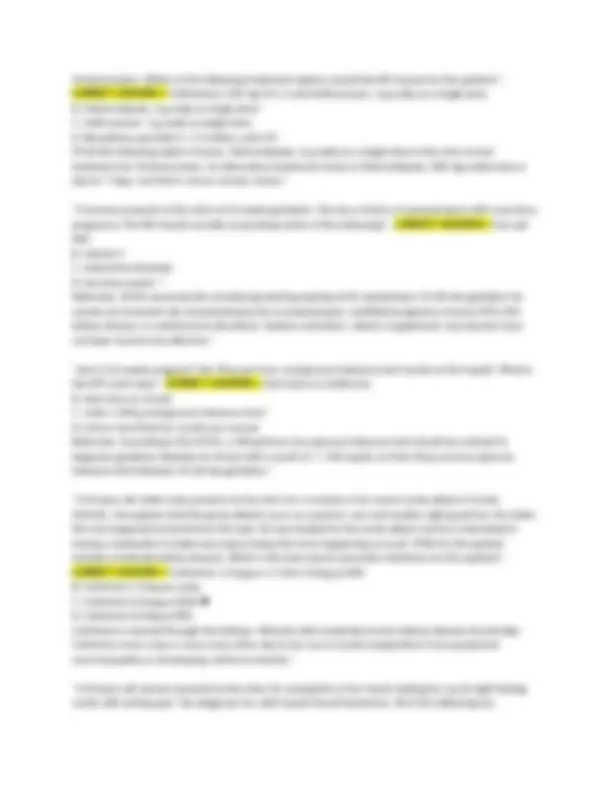
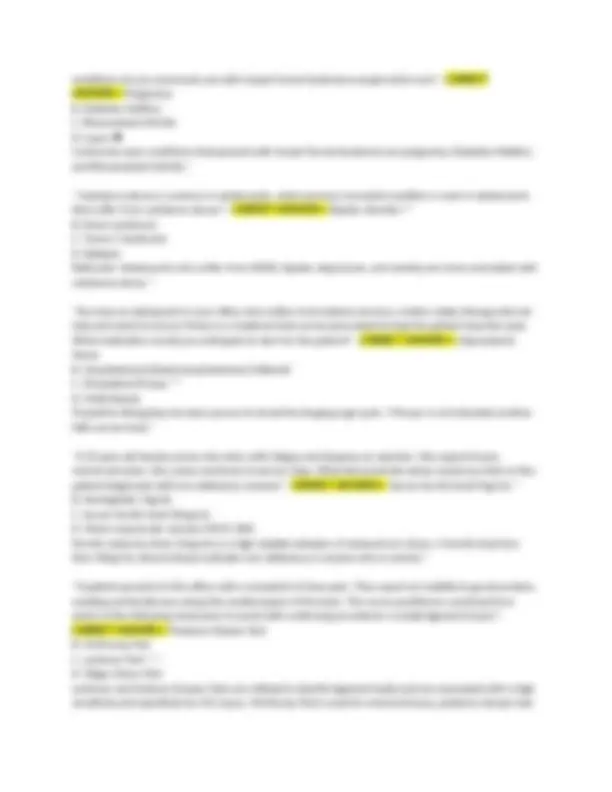
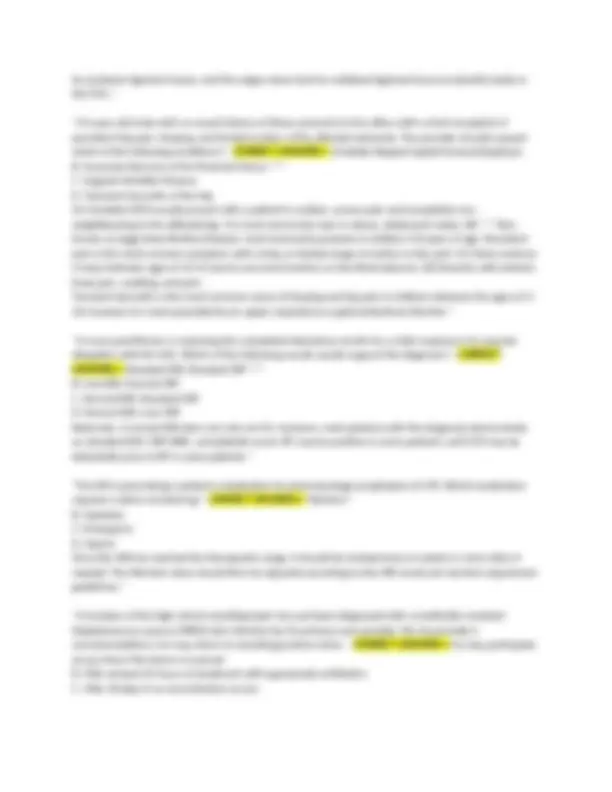
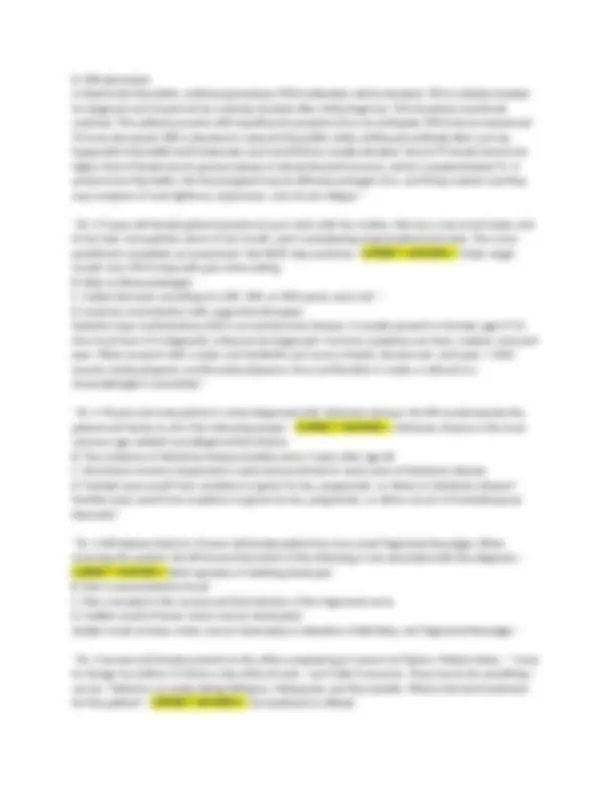
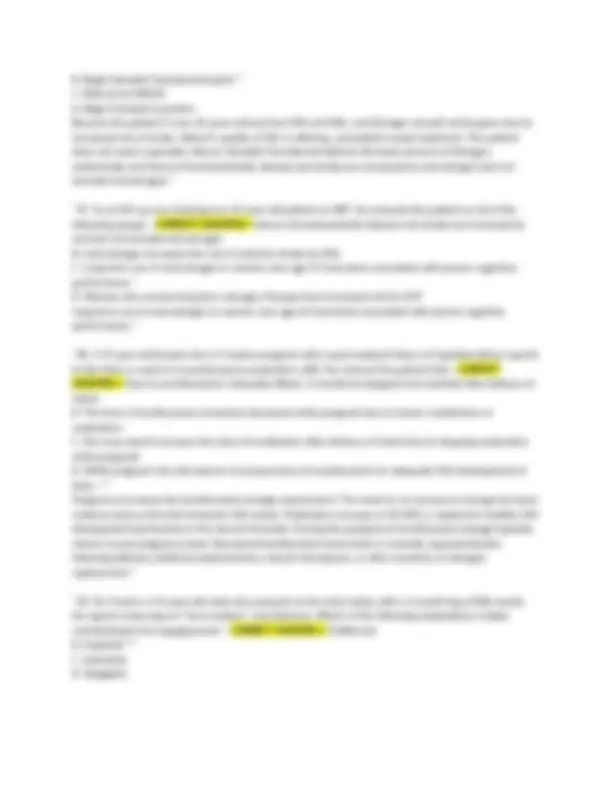
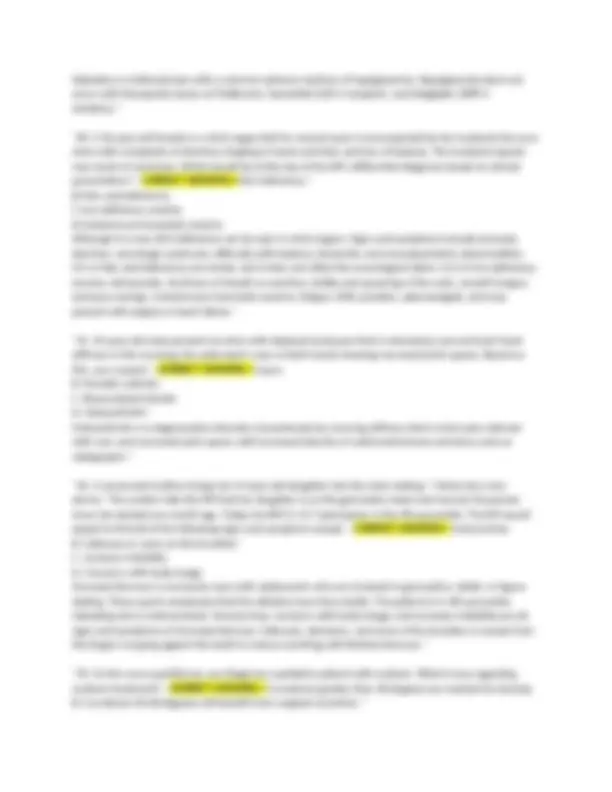
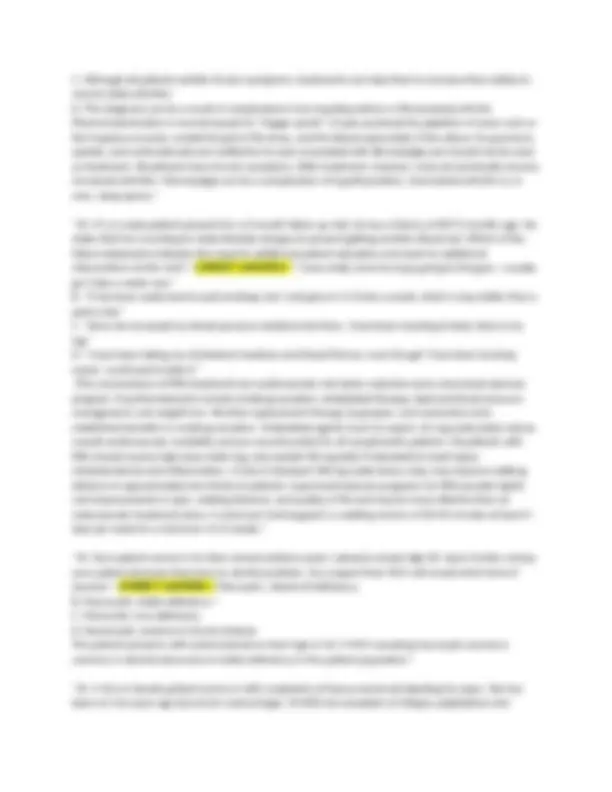
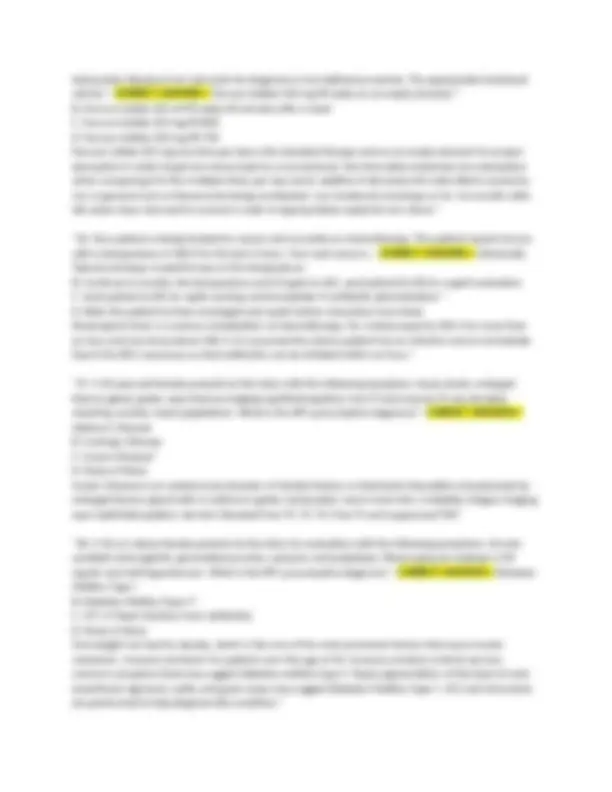
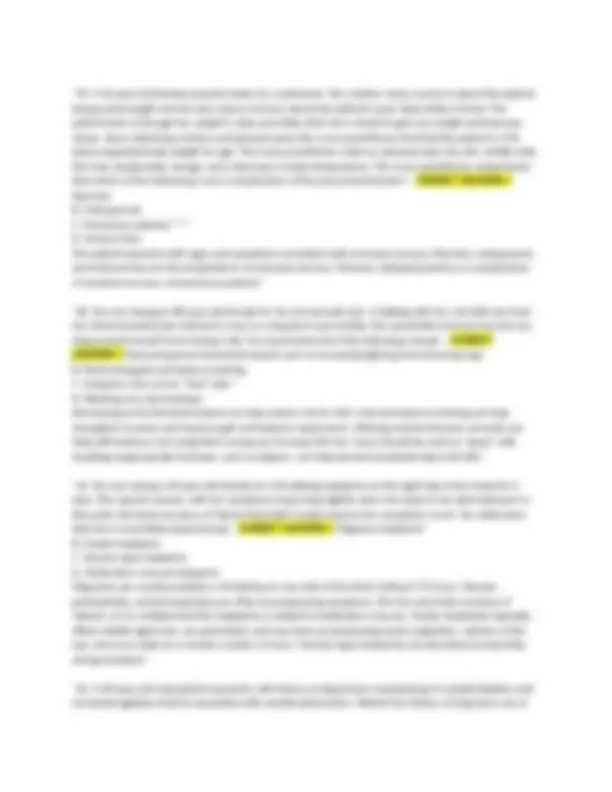
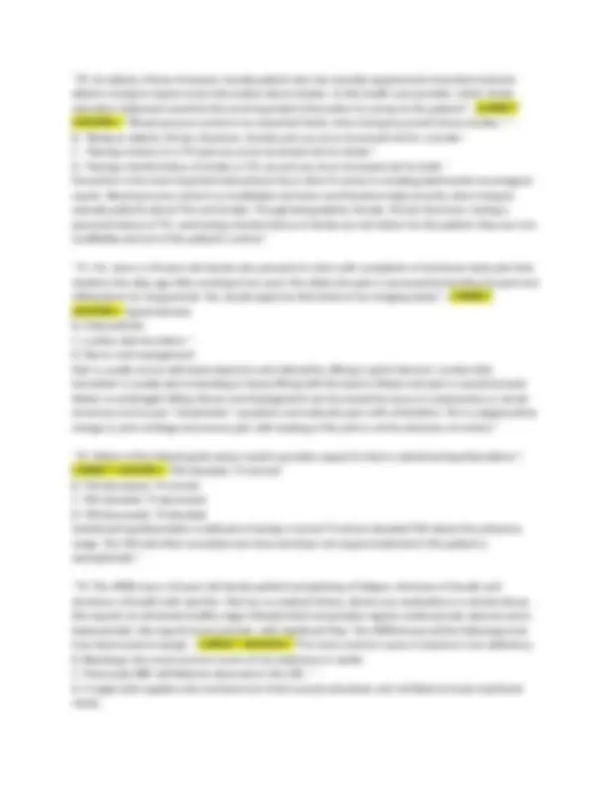
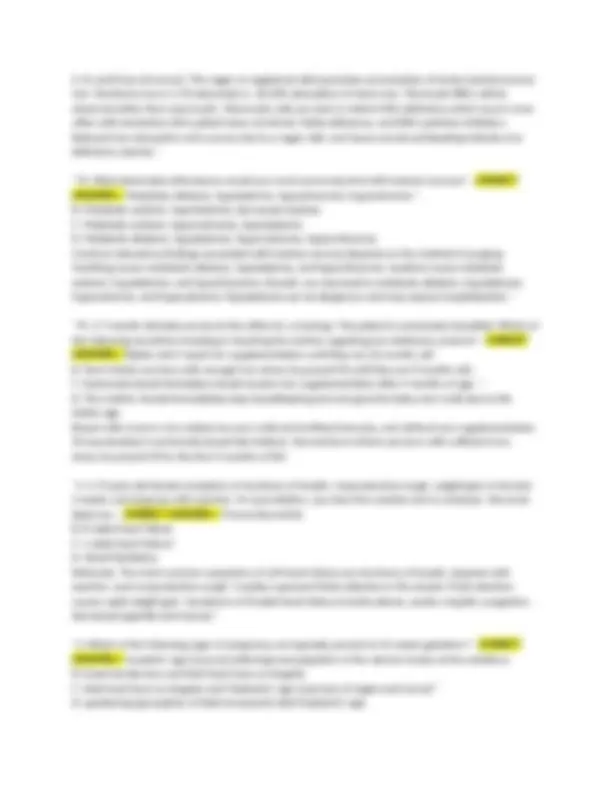
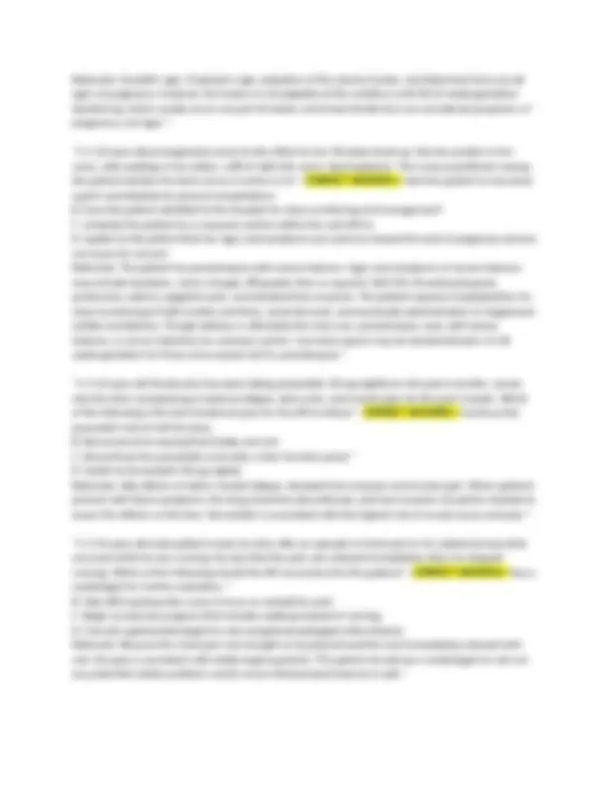
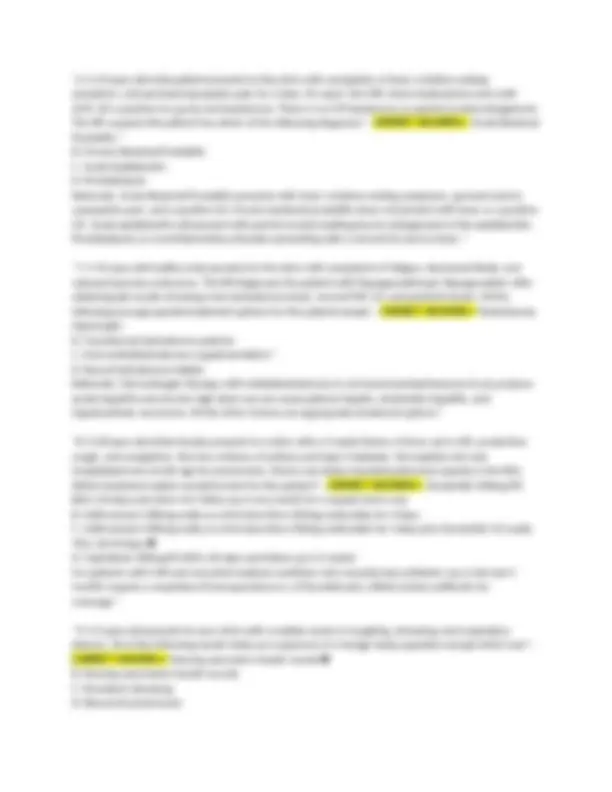
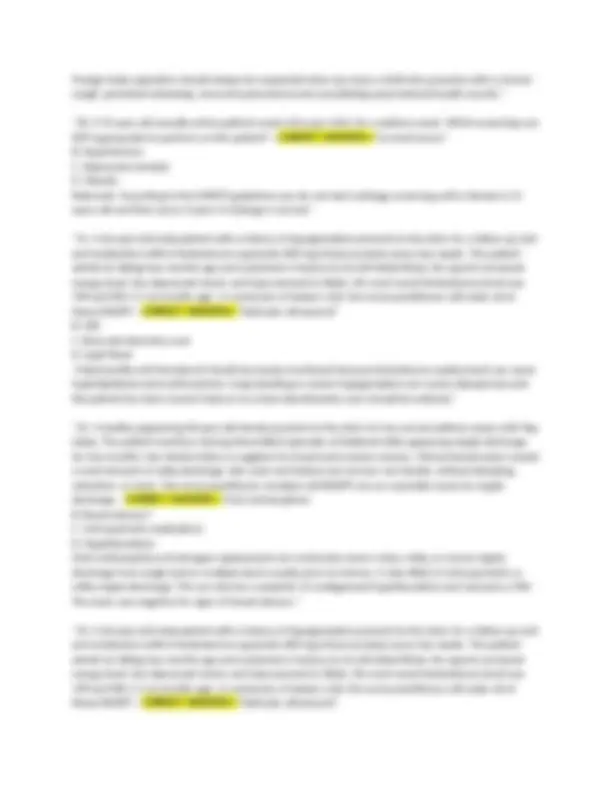
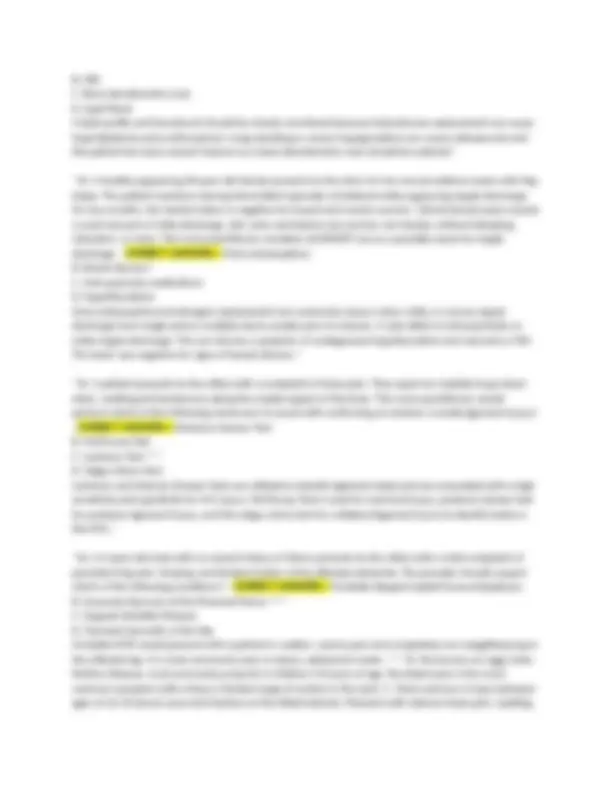
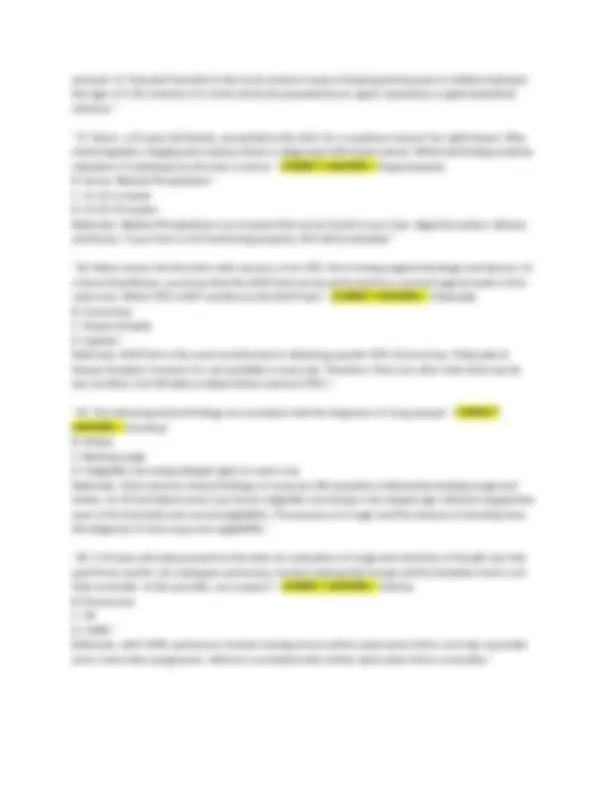
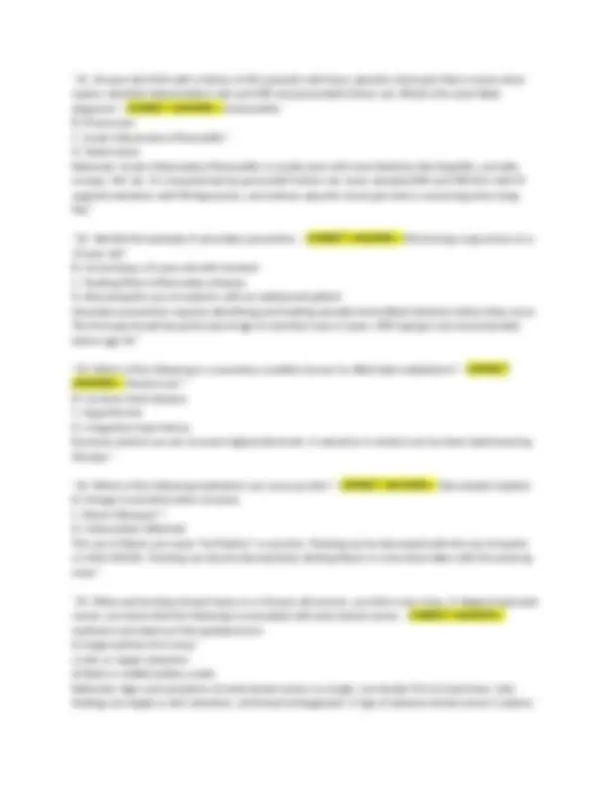
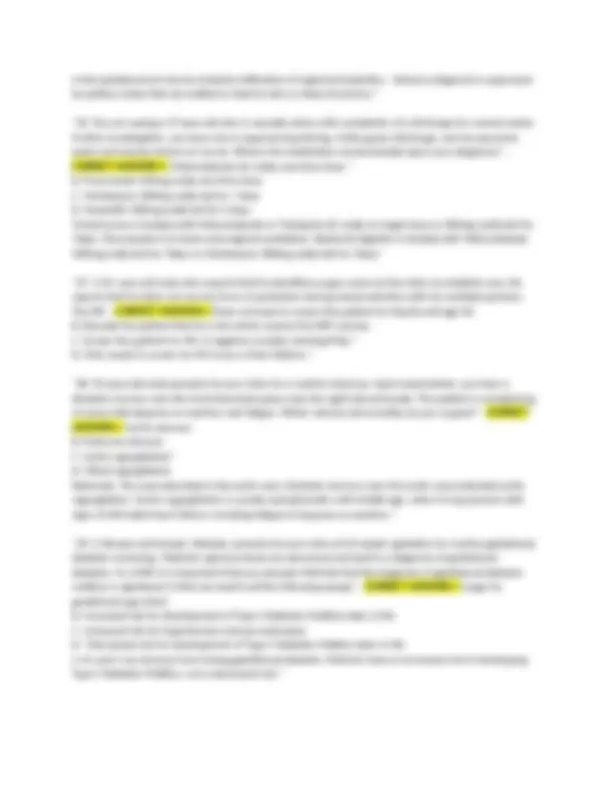
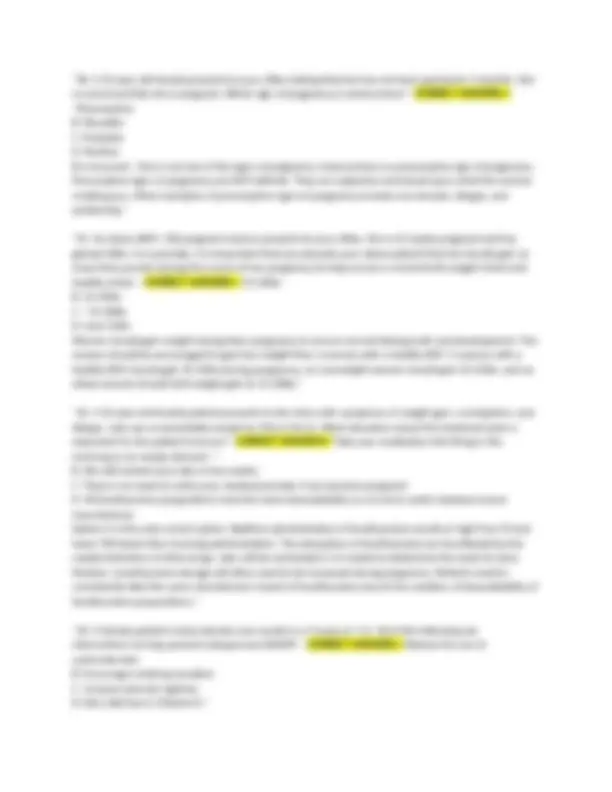
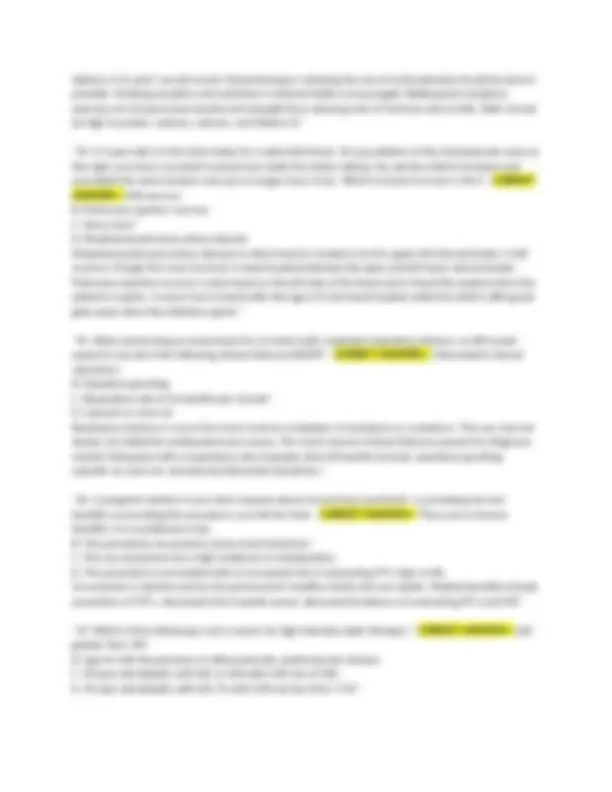
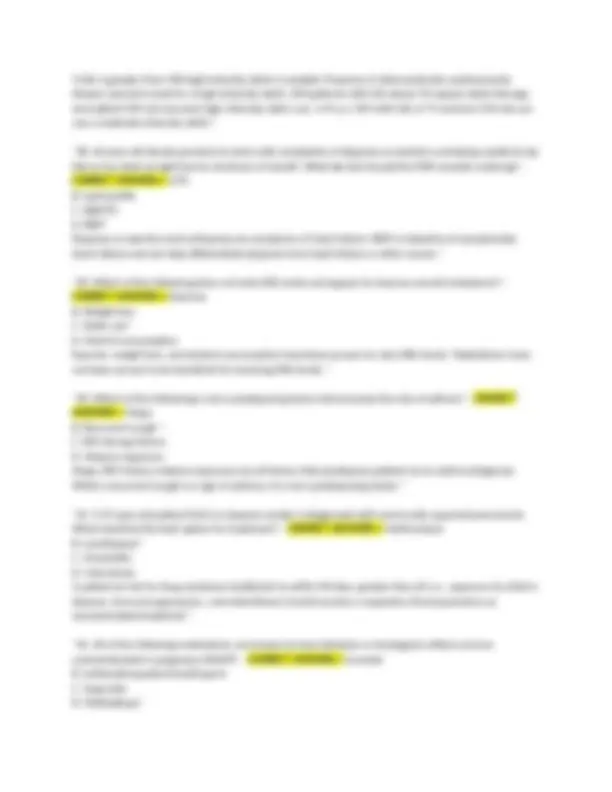
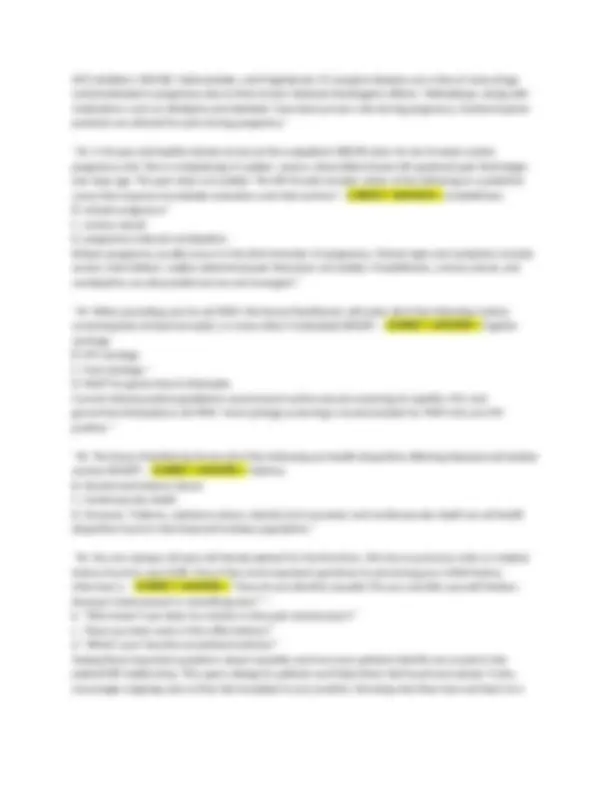
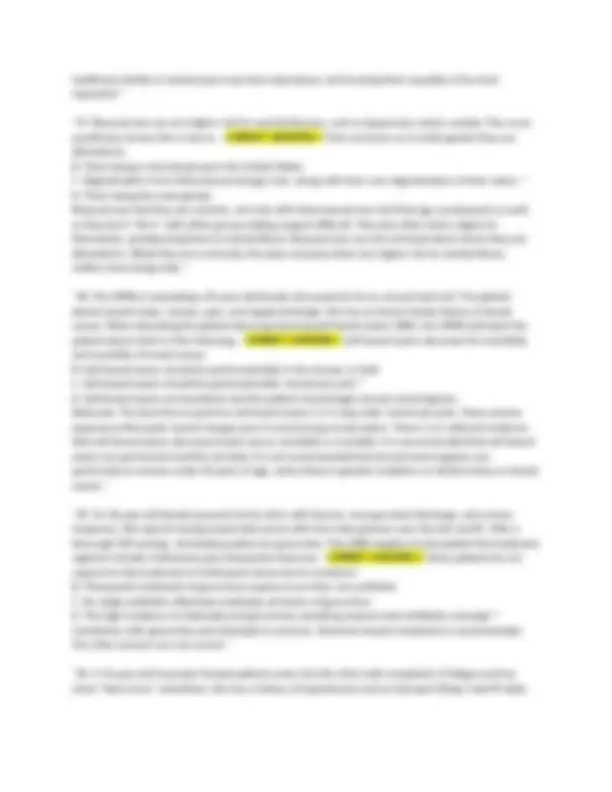
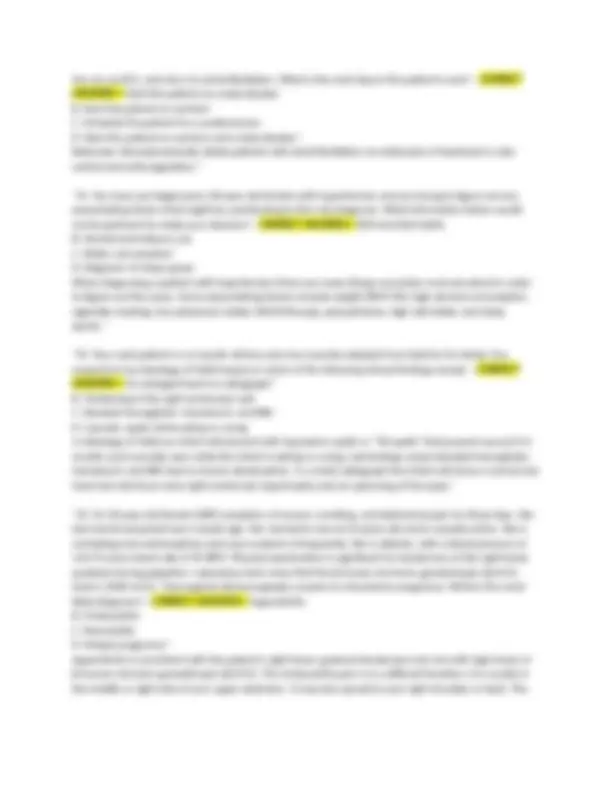
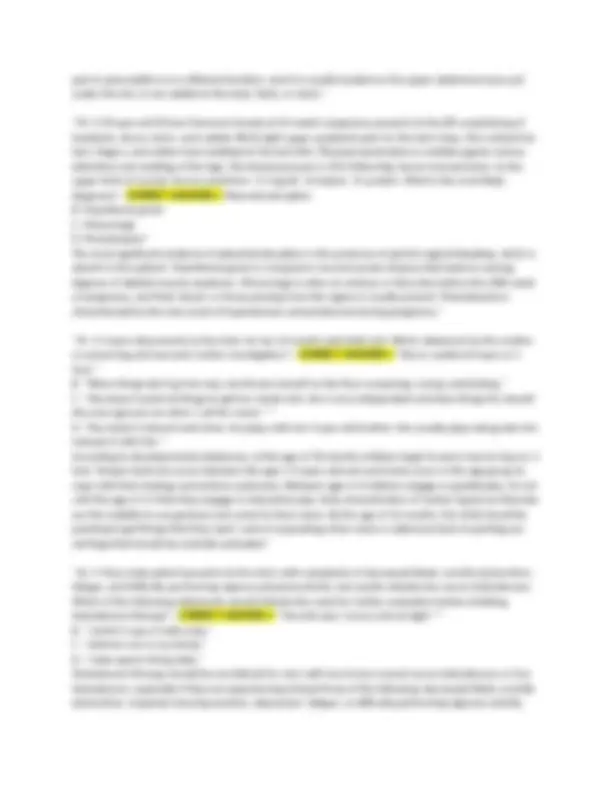
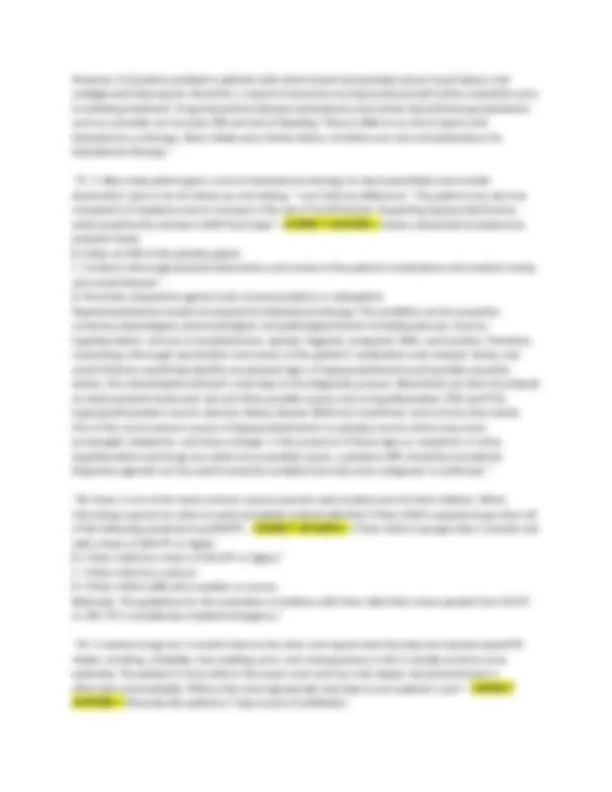
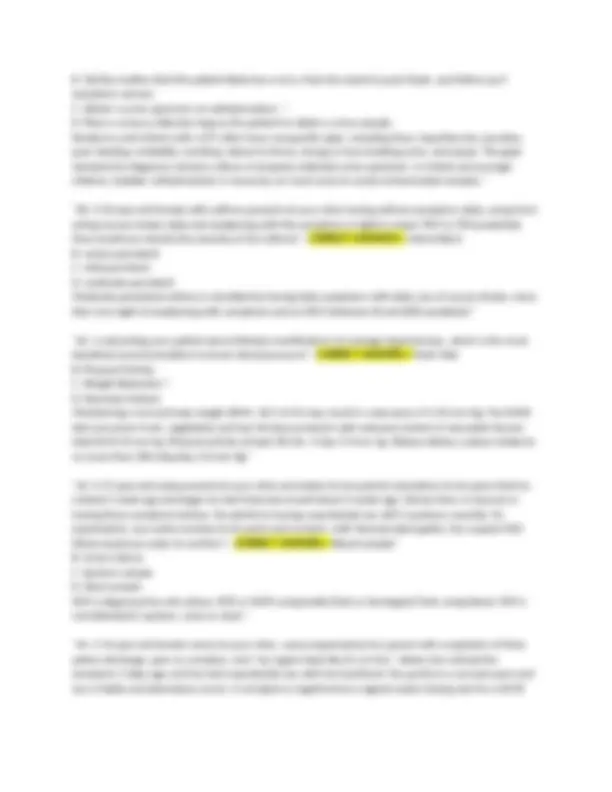
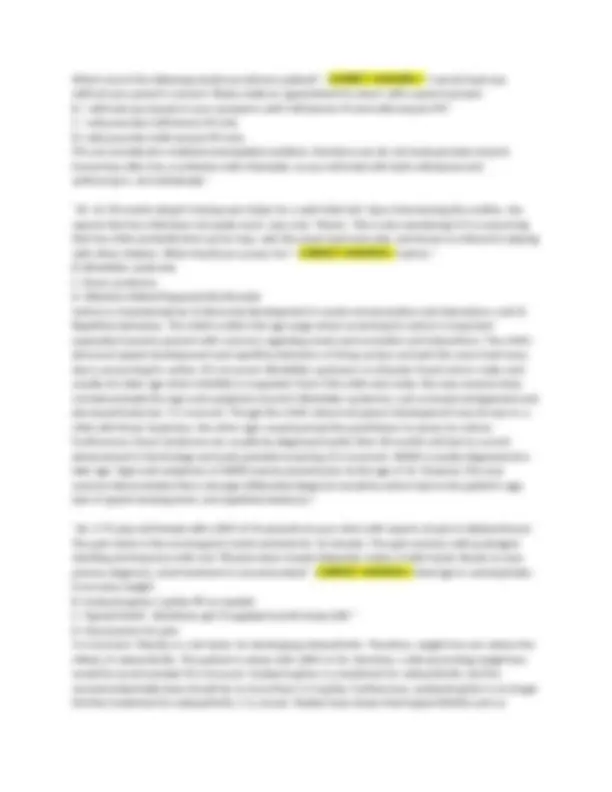
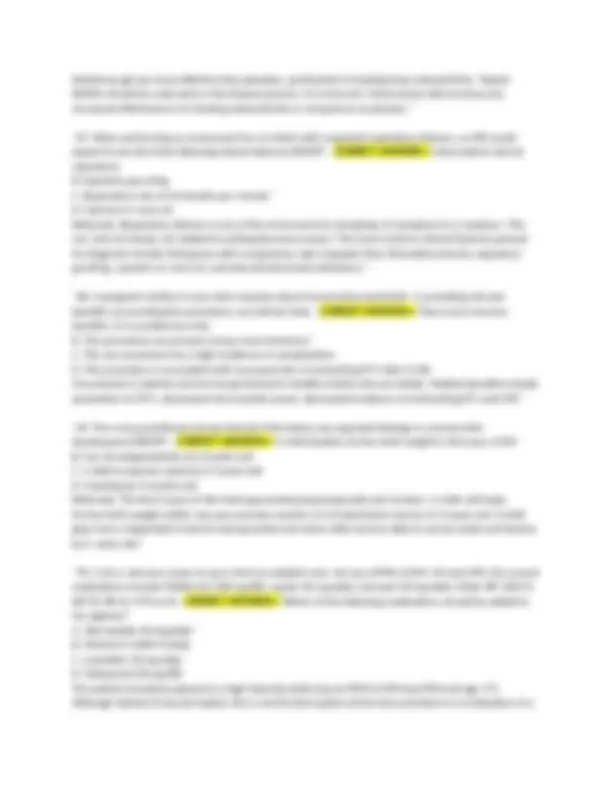
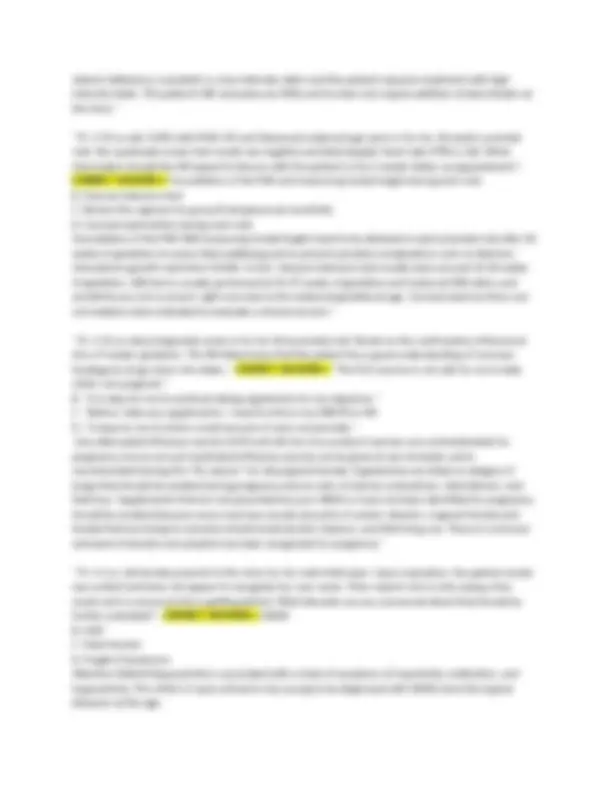
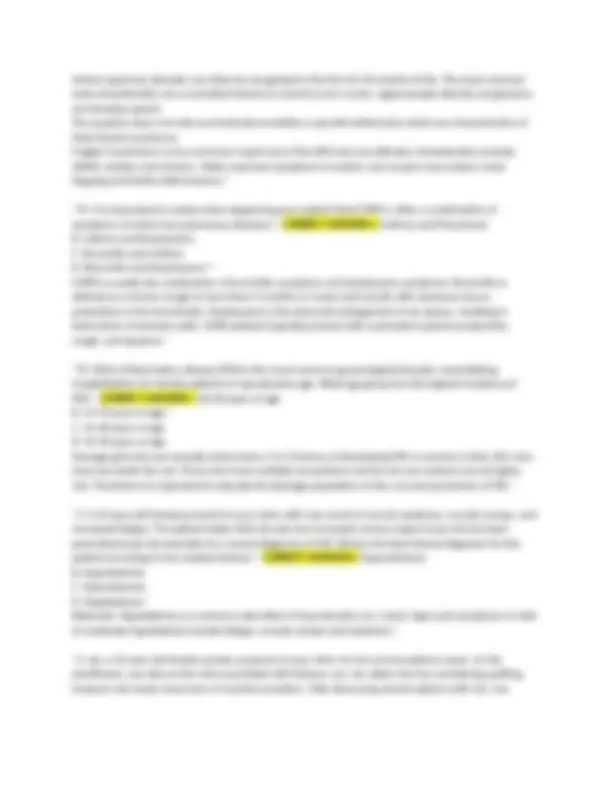
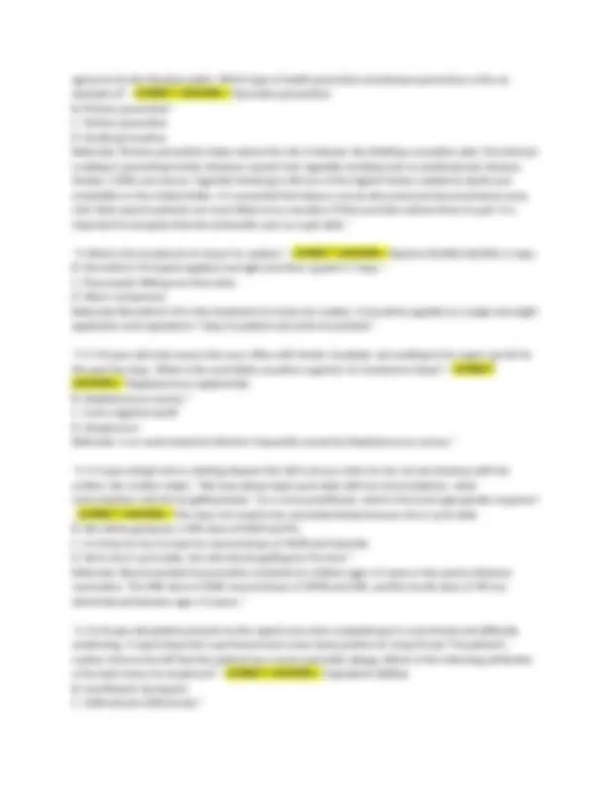

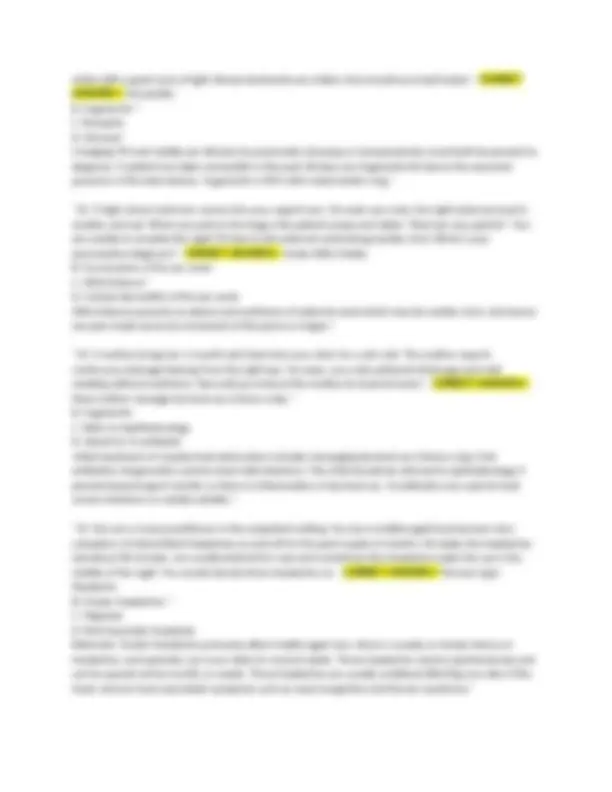
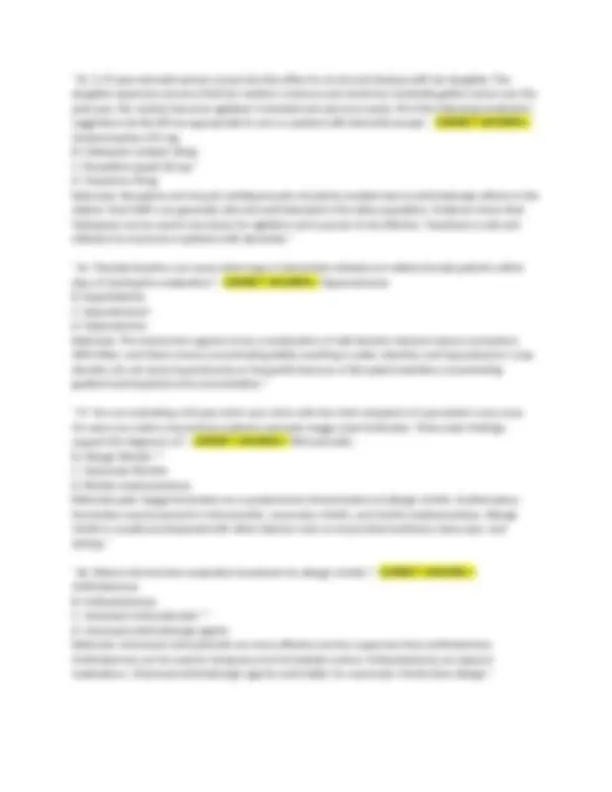
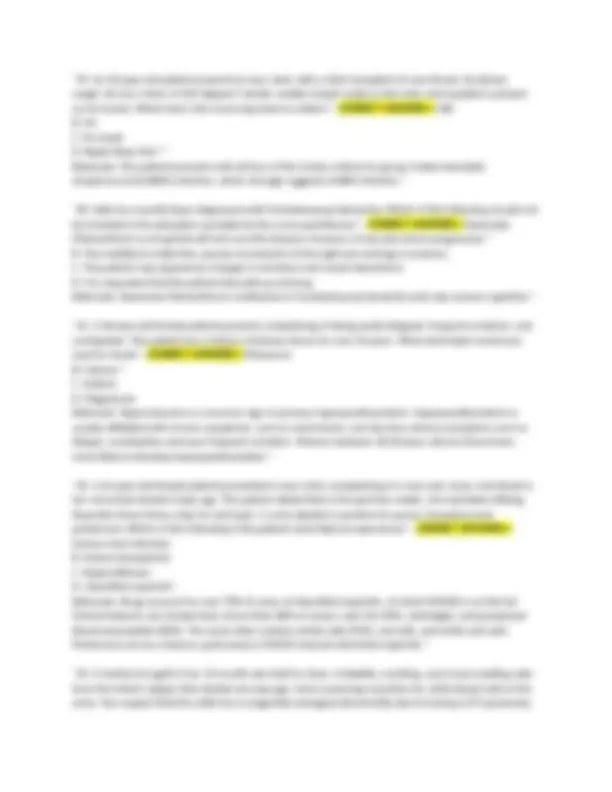
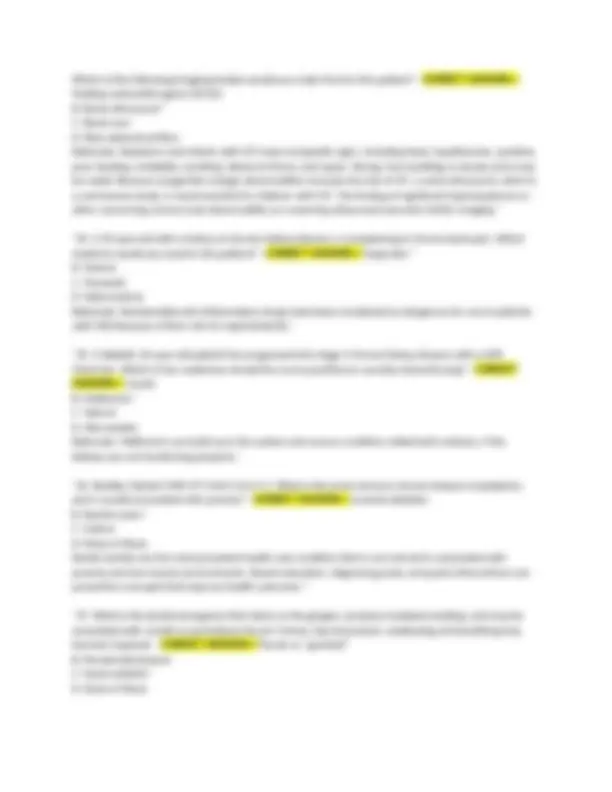
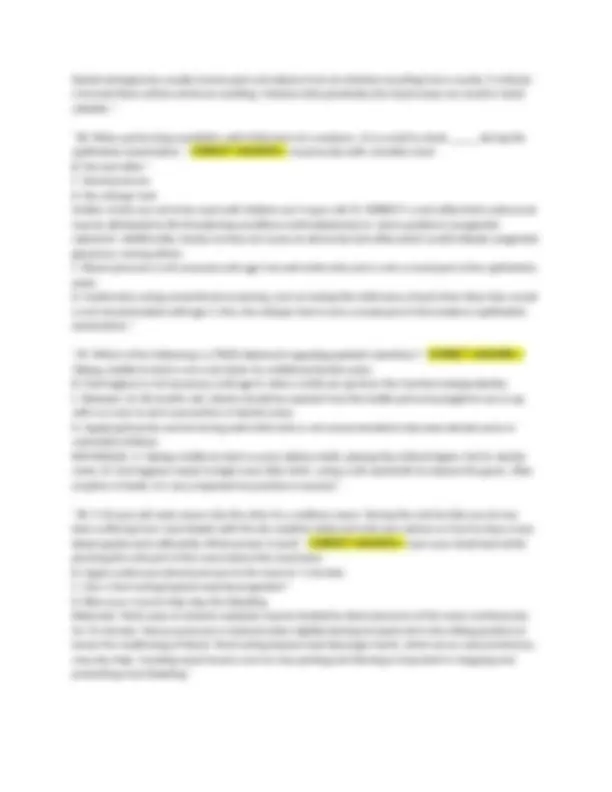
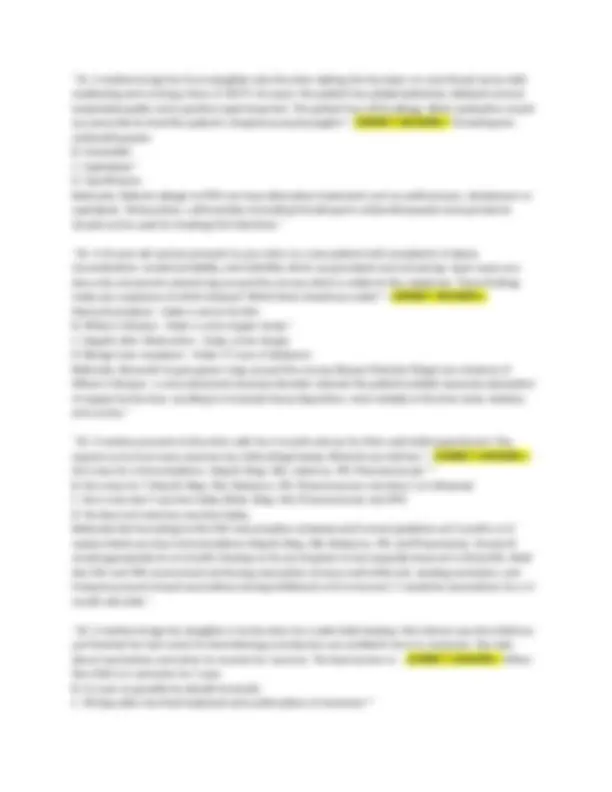
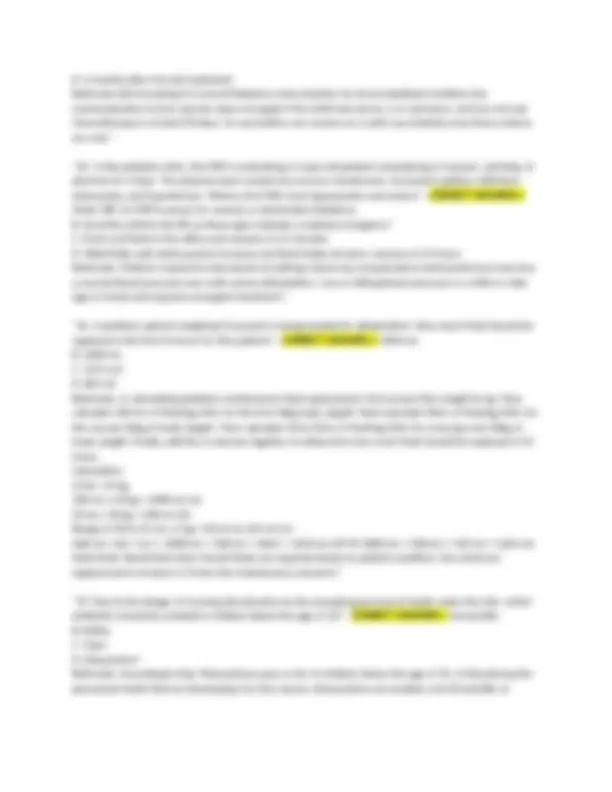
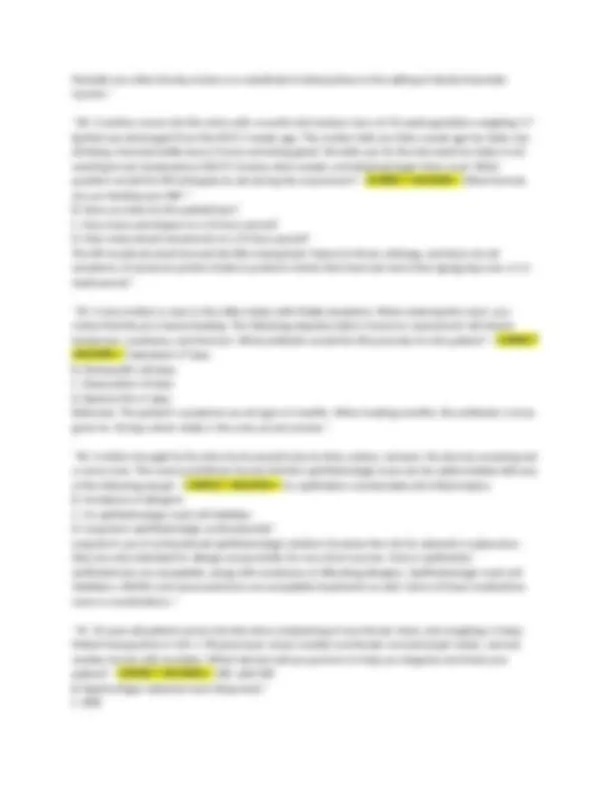
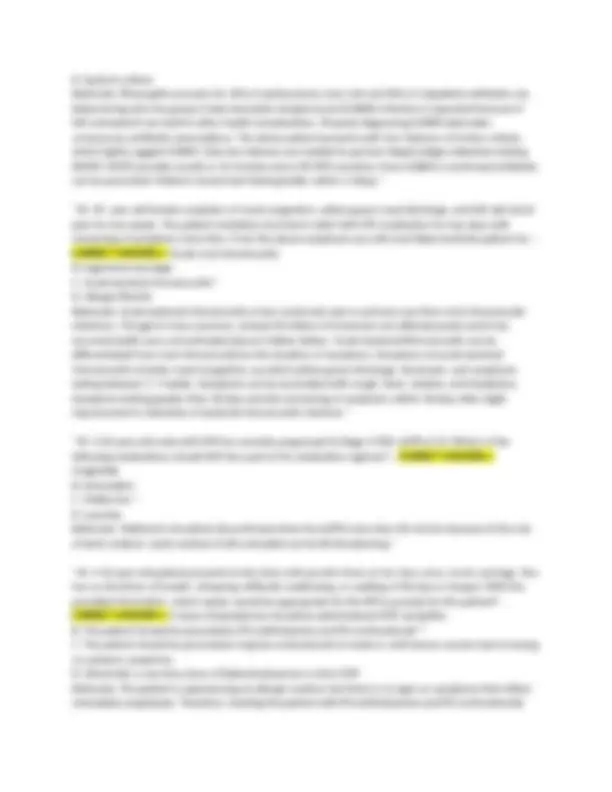
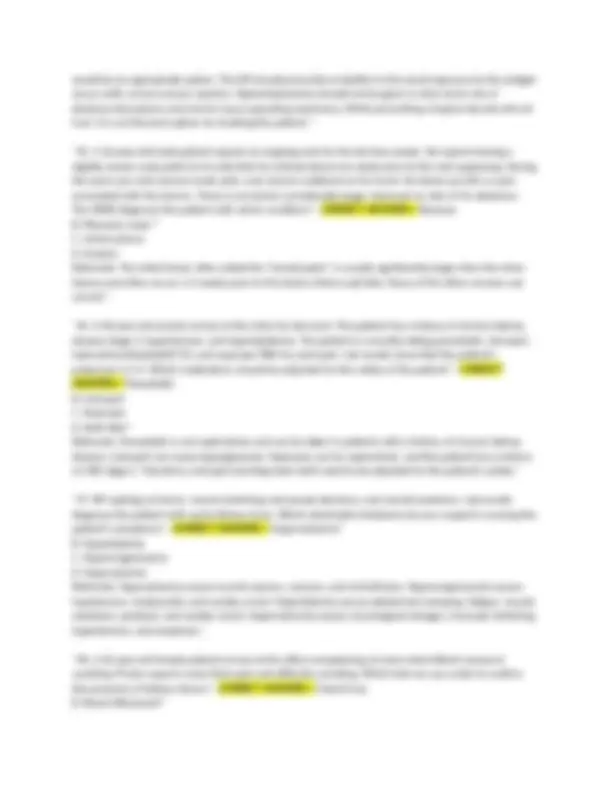
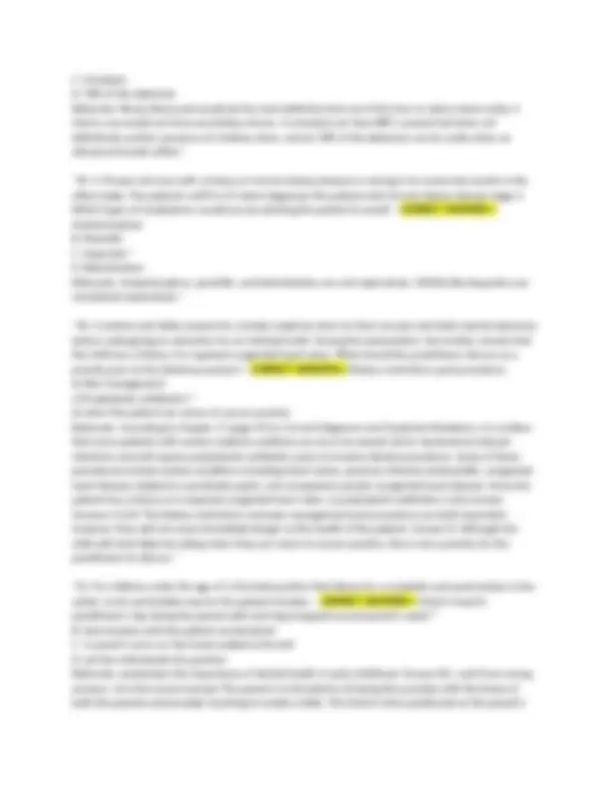
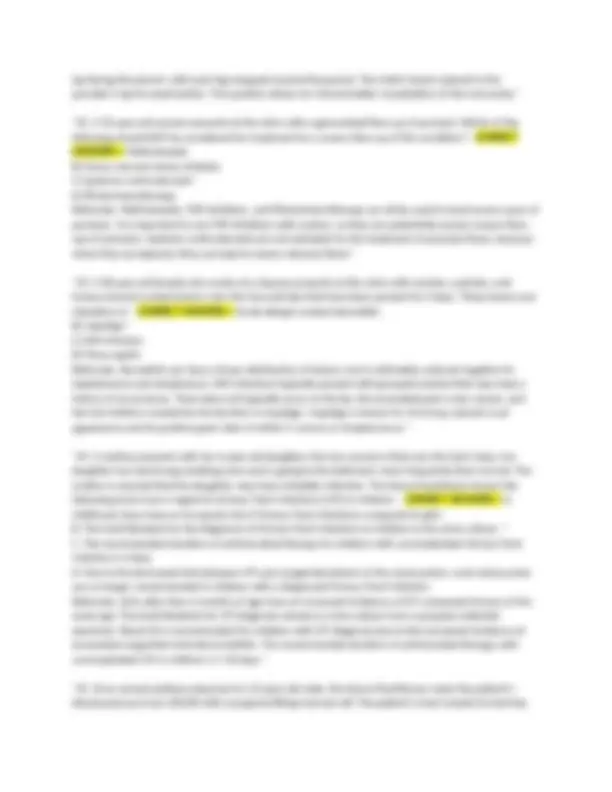
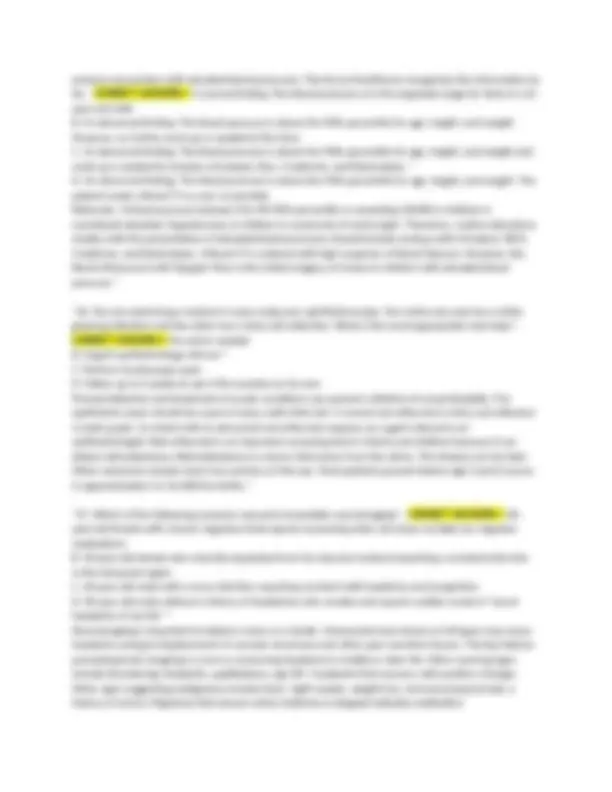
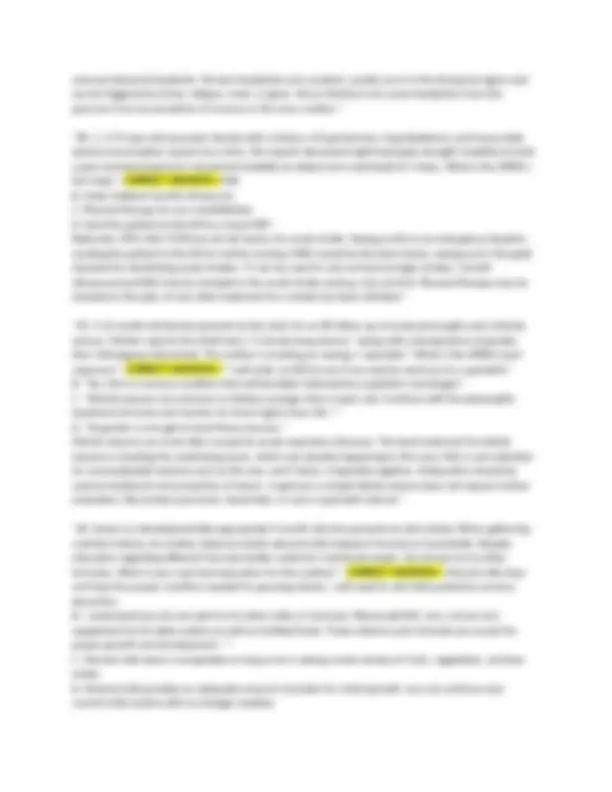
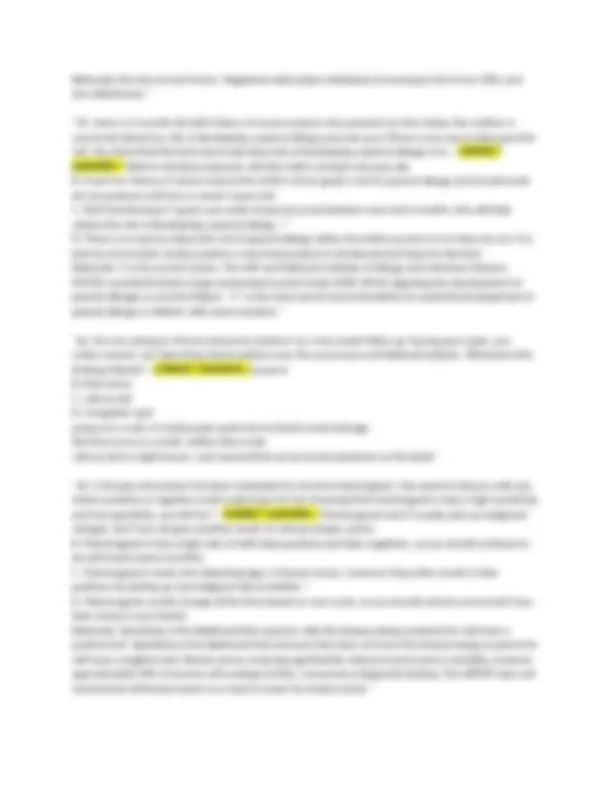
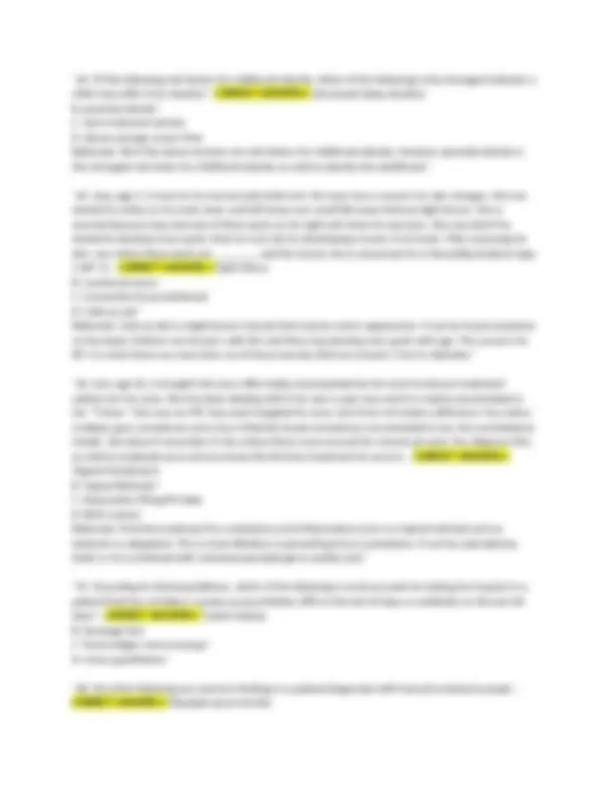

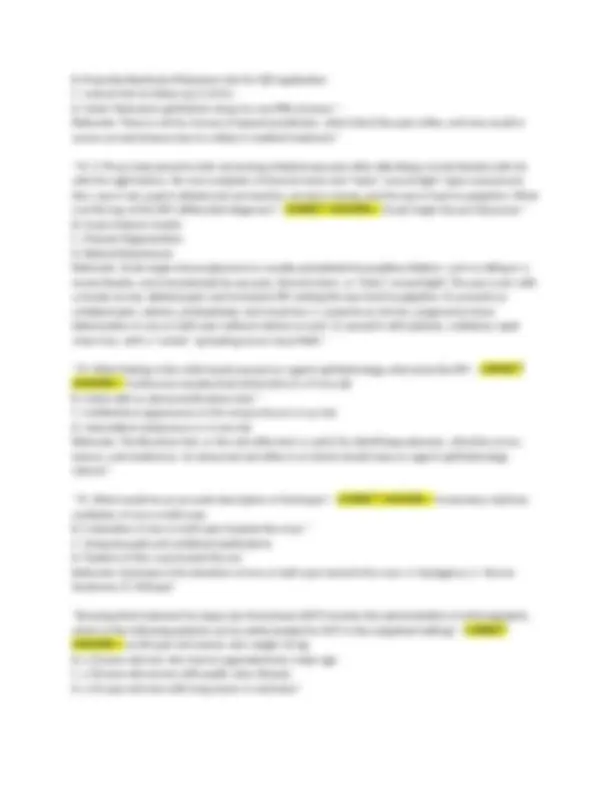
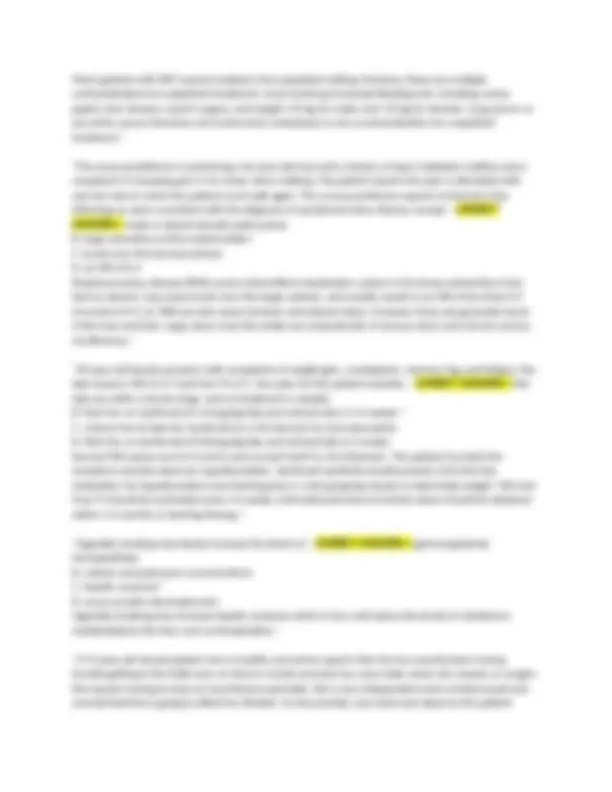
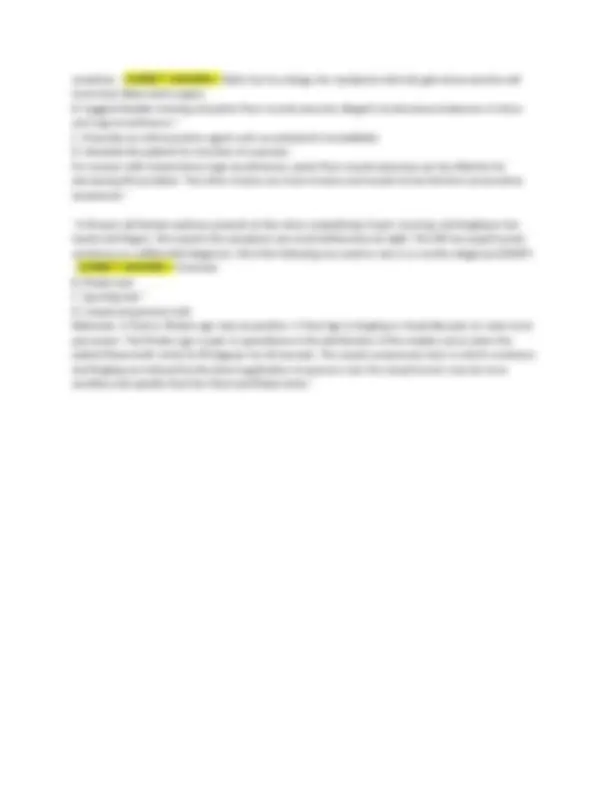


Study with the several resources on Docsity

Earn points by helping other students or get them with a premium plan


Prepare for your exams
Study with the several resources on Docsity

Earn points to download
Earn points by helping other students or get them with a premium plan
Community
Ask the community for help and clear up your study doubts
Discover the best universities in your country according to Docsity users
Free resources
Download our free guides on studying techniques, anxiety management strategies, and thesis advice from Docsity tutors
A collection of multiple-choice questions and answers related to various topics in the field of nursing. It covers a range of clinical scenarios and medical conditions, including urinary incontinence, prostatitis, sexually transmitted infections, pregnancy complications, and gouty arthritis. Designed to help students prepare for their final exam in cmn 577, a nursing course.
Typology: Quizzes
1 / 61

This page cannot be seen from the preview
Don't miss anything!






















































"A 66-year-old Hispanic female presents with a two-year history of detrusor overactivity or "urge incontinence. She has been treated by a physical therapist with bladder training therapy for one year, buts fail to provide appropriate relief. The next possible treatment would be: - CORRECT ANSWER=> Tolterodine 1-2 mg orally 2x daily B. Oxybutynin 2.5 - 5mg orally 2-3x daily C. Refer to OB/Gyn for a pessary fitting D. All of the above* Antimuscarinic agents such as tolterodine or oxybutynin may provide additional benefit in stress incontinence issues. These medications must be used with caution due to the side effects of dry mouth, urine retention, and delirium. A pessary may also be of additional benefit but should be prescribed only by providers who are experienced in the selection, placement, and management of these devices." "A 23-year-old male patient presents to the clinic with complaints of fever, irritative voiding symptoms, and perineal/suprapubic pain for 2 days. On exam, the CBC shows leukocytosis and a left shift. UA is positive for pyuria and bacteriuria. There is no CVA tenderness or painful scrotal enlargement. The NP suspects the patient has which of the following diagnosis? - CORRECT ANSWER=> Acute Bacterial Prostatitis * B. Chronic Bacterial Prostatitis C. Acute Epididymitis D. Prostatodynia Acute Bacterial Prostatitis presents with fever, irritative voiding symptoms, perineal and/or suprapubic pain, and a positive UA. Chronic bacterial prostatitis does not present with fever or a positive UA. Acute epididymitis will present with painful scrotal swelling due to enlargement of the epididymitis. Prostatodynia is a noninflammatory disorder presenting with a normal UA and no fever." "A 24-year-old female who identifies as a lesbian, presents for her annual wellness visit. She has multiple female sexual partners. She did not receive the HPV vaccine and has not had a cervical cancer screening since she was 21 years old. Which of the following is not recommended in the treatment plan for this patient? - CORRECT ANSWER=> HPV vaccination series B. Papanicolaou (PAP) smear with HPV co-testing* C. Chlamydia trachomatis and Neisseria gonorrhea testing D. Screen for Intimate Partner Violence (IPV)
Chlamydial infections were higher in 14- to 24-year-old women who reported same-sex behavior when compared with exclusively heterosexual women. Untreated chlamydial infection places a woman's future fertility at risk due to potential tubal occlusion. Some women who have a chlamydia infection do not have symptoms. Secondary sequelae of chlamydia include intra-abdominal abscesses, chronic pain, and the need for multiple surgeries. Regardless of sexual orientation, the CDC recommends annual Chlamydia trachomatis (and Neisseria gonorrhea) screening from the age of first sexual activity to the age of 25 years for all women. Compared to heterosexual women, lesbians and bisexual women have higher exposure to violence throughout their lifetimes. The lifetime prevalence of sexual assault may be as high as 85%. It is essential to screen all women for IPV but especially those in the LGBTQ community due to these alarming statistics. The primary prevention of cervical cancer is essential. All females between the ages of 12 and 26 years should receive the HPV vaccine series even if they never have been or plan to be sexually active with men. HPV is transmitted sexually between lesbian or heterosexual partners. The rate of HPV immunization among lesbians is significantly less than for heterosexual women, which creates a health disparity that needs to be corrected. While she is due for a PAP smear, the PAP with HPV co-testing is not recommended in women under the age of 30 years old." "All of the following can help reduce the risk of adolescents developing STIs except: - CORRECT ANSWER=> a monogamous sexual relationship with one partner B. the use of a condom C. abstinence D. birth control Abstinence, a monogamous sexual relationship with one partner, and proper condom use has shown to reduce the risk of adolescents developing sexually transmitted infections. On the other hand, birth control only helps to prevent pregnancy and does not offer any protection against STIs." "A 57-year-old female comes into the clinic with complaints of hot flashes and vaginal dryness. She is a smoker and has hypertension. When giving her hormone replacement options, the NP informs her best option is: - CORRECT ANSWER=> Oral estrogen B. Oral estrogen with progesterone C. Estradiol injections D. Transdermal estrogen* Transdermal or vaginal estrogen avoids the risks of deep vein thrombosis and ischemic strokes." "When evaluating a patient with intermittent claudication, the Nurse Practitioner would expect to find all the following except: - CORRECT ANSWER=> Diminished femoral pulses B. An ankle-brachial index of 1.0 * C. Reproducible pain in the calf muscles when walking D. An ankle-brachial index of 0. Intermittent claudication is pain that occurs because of insufficient blood flow during times of increased demand, such as exercise. The pain is relieved with rest and is reproducible when the patient begins to walk again. Femoral pulses are usually absent or very weak and the ankle-brachial index is below 0.9." "A 17-year-old sexually active female presents to the clinic with complaints of vaginal pruritis, dysuria, and a thick, greenish, malodorous discharge. After further testing, it is confirmed that she is positive for
conditions do you commonly see with Carpal Tunnel Syndrome except which one? - CORRECT ANSWER=> Pregnancy B. Diabetes Mellitus C. Rheumatoid Arthritis D. Lupus ✱ Commonly seen conditions that present with Carpal Tunnel Syndrome are pregnancy, Diabetes Mellitus, and Rheumatoid Arthritis." " Substance abuse is common in adolescents, what common comorbid condition is seen in adolescents that suffer from substance abuse? - CORRECT ANSWER=> Bipolar disorder** B. Down syndrome C. Turner's Syndrome D. Epilepsy Rationale: Adolescents who suffer from ADHD, bipolar, depression, and anxiety are more associated with substance abuse." "You have an adolescent in your office who suffers from bulimia nervosa, mother states therapy did not help and wants to know if there is a medicine that can be prescribed to help the patient stop the cycle. What medication would you anticipate to start for the patient? - CORRECT ANSWER=> (Alprazolam) Xanax B. (Amphetamine\Dextroamphetamine) Adderall C. (Fluoxetine) Prozac ** D. Multivitamin Fluoxetine 60mg\day has been proven to break the binge\purge cycle. If Prozac is not tolerated another SSRI can be tried." "A 32-year-old female comes into clinic with fatigue and dyspnea on exertion. She reports heavy menstrual cycles. She craves and loves to eat ice chips. What abnormal lab values would you find on this patient diagnosed with iron deficiency anemia? - CORRECT ANSWER=> Serum ferritin level 9ng/mL * B. Hemoglobin 14g/dL C. Serum ferritin level 50ng/mL D. Mean corpuscular volume (MCV): 86fL Ferritin value less than 12ng/mL is a high reliable indicator of reduced iron stores. A ferritin level less than 30ng/mL almost always indicates iron deficiency in anyone who is anemic." "A patient presents to the office with a complaint of knee pain. They report an inability to go downstairs, swelling and tenderness along the medial aspect of the knee. The nurse practitioner would perform which of the following maneuvers to assist with confirming an anterior cruciate ligament injury? - CORRECT ANSWER=> Posterior Drawer Test B. McMurray Test C. Lachman Test *** D. Valgus Stress Test Lachman and Anterior Drawer Tests are utilized to identify ligament laxity and are associated with a high sensitivity and specificity for ACL injury. McMurray Test is used for meniscal injury, posterior drawer test
for posterior ligament injury, and the valgus stress test for collateral ligament injury to identify laxity in the MCL." "A 6-year-old male with no recent history of illness presents to the office with a chief complaint of persistent hip pain, limping, and limited motion of the affected extremity. The provider should suspect which of the following conditions? - CORRECT ANSWER=> Unstable Slipped Capital Femoral Epiphysis B. Avascular Necrosis of the Proximal Femur *** C. Osgood-Schlatter Disease D. Transient Synovitis of the Hip (A) Unstable SCFE would present with a patient in sudden, severe pain and completely non- weightbearing in the affected leg. It is most commonly seen in obese, adolescent males. (B) **Also known as Legg-Calve-Perthes Disease; most commonly presents in children 4-8 years of age. Persistent pain is the most common symptom with a limp or limited range of motion in the joint. (C) Most common in boys between ages of 12-15 due to recurrent traction on the tibial tubercle. (D) Presents with anterior knee pain, swelling, and pain. Transient Synovitis is the most common cause of limping and hip pain in children between the ages of 3- 10, however it is most preceded by an upper respiratory or gastrointestinal infection." "A nurse practitioner is reviewing the completed laboratory results for a child suspicious for juvenile idiopathic arthritis (JIA). Which of the following results would support this diagnosis? - CORRECT ANSWER=> Elevated ESR, Elevated CRP *** B. Low ESR, Normal CRP C. Normal ESR, Elevated CRP D. Normal ESR, Low CRP Rationale: A normal ESR does not rule out JIA, however, most patients with this diagnosis demonstrate an elevated ESR, CRP, WBC, and platelet count. RF may be positive in some patients, anti-CCP may be detectable prior to RF in some patients." "The NP is prescribing a patient a medication for pharmacologic prophylaxis of VTE. Which medication requires routine monitoring? - CORRECT ANSWER=> Warfarin B. Apixaban C. Enoxaparin D. Aspirin Once the INR has reached the therapeutic range, it should be checked every 6 weeks or more often if needed. The Warfarin dose should then be adjusted according to the INR result and warfarin adjustment guidelines." "A member of the high school wrestling team has just been diagnosed with a methicillin-resistant Staphylococcus aureus (MRSA) skin infection by his primary care provider. Per his provider's recommendations, he may return to wrestling practice when: - CORRECT ANSWER=> he may participate at any time if the lesion is covered B. After at least 24 hours of treatment with appropriate antibiotics C. After 30 days if no new infection occurs
A. Obtain a CBC and CMP in the clinic. B. Refer to Neurologist. C. Order a carotid US and echocardiogram. D. Send to ED immediately for STAT CT head without contrast and stroke evaluation.* Essentials of Diagnosis: sudden onset of neurological deficit of cerebrovascular origin. Risk factors are: HTN, DM, tobacco use, atrial fibrillation, or atherosclerosis. If a stroke is suspected, a Head CT without contrast should be performed immediately, before administering aspirin or other antithrombotic agents. IV thrombolytic therapy is effective up to 4.5 hours from stroke onset." "A post-menopausal woman is in the office with complaints of low libido. She is interested in starting hormone replacement therapy (HRT) to increase her libido. Which of the following statements would be correct teaching on the risks related to HRT in post-menopausal women? - CORRECT ANSWER=> "There are no known risk factors to HRT in post-menopausal women. Therefore, it would be an appropriate therapy for you." B. "The risks of long-term HRT include heart attack, stroke, gallstones, breast cancer, and increased mortality. These risks are increased if you start HRT after menopause."* C. "The risks of long-term HRT include heart attack, stroke, gallstones, breast cancer, and increased mortality. These risks are reduced if HRT is started after menopause." D. "There are risks associated with HRT, but they are minimal; therefore, the benefits outweigh the risks." Double-blind randomized control trials have shown that the risks of long-term HRT include heart attack, stroke, gallstones, breast cancer, and increased mortality rates. There is a decreased risk for these occurring if the HRT was started in menopause. It is still generally considered not safe to maintain long- term HRT therapy as the risks do not outweigh the benefits." "31. A good clinician understands which of the following principles to be true about using diagnostic tests for diagnosis and management of disease? - CORRECT ANSWER=> If a diagnostic test is positive, the patient definitely has the disease. B. If a diagnostic test is sensitive for a disease, it can correctly identify patients without the disease. C. If a diagnostic test is specific for a disease, it can correctly identify patients with the disease. D. If a diagnostic test is positive, sensitivity and specificity of the test should be considered along with the patient's clinical presentation.* Rationale: The usefulness of a diagnostic test should not be based solely on their predictive measures (sensitivity and specificity), but also the probability that the patient has the disease. The sensitivity of a test is the ability to correctly identify those with the disease. The specificity of a test is the ability to correctly identify those without the disease." "32. A 36-year-old female presents to your clinic with depression, ongoing fatigue, anterior neck tightness without pain, and weight gain. You palpate the thyroid notice goiter and a lumpy texture. There is a positive family history of thyroid problems; mother with hypothyroidism and T1DM. To work up the thyroid for this patient, what lab is specific to your potential diagnosis? - CORRECT ANSWER=> TSH decreased B. T4 increased C. TPO elevation*
D. ESR decreased In Hashimoto thyroiditis, antithyroperoxidase (TPO) antibodies will be elevated. TPO is initially checked for diagnosis and should not be routinely checked after initial diagnosis; TSH should be monitored routinely. This patient presents with hypothyroid symptoms thus we anticipate TSH to be increased and T4 to be decreased. ESR is elevated in subacute thyroiditis while antithyroid antibody titers are low. Suppurative thyroiditis both leukocyte count and ESR are usually elevated. Serum FT4 levels tend to be higher than t3 levels due to passive release of stored thyroid hormone, which is predominately T4. In autoimmune thyroiditis, the thyroid gland may be diffusely enlarged, firm, and finely nodular and they may complain of neck tightness, depression, and chronic fatigue." "33. A 9-year-old female patient presents to your clinic with her mother. She has a new onset malar rash to her face, two painless ulcers in her mouth, and is complaining of generalized joint pain. The nurse practitioner completes an assessment. Her NEXT step would be - CORRECT ANSWER=> Order magic mouth rinse TID to help with pain when eating. B. Refer to Rheumatologist. C. Collect lab work consisting of a CBC, ESR, an ANA panel, and a UA. * D. treat her viral infection with supportive therapies. Systemic lupus erythematous (SLE) is an autoimmune disease. It usually presents in females ages 9-15. One must have 4/11 diagnostic criteria to be diagnosed. Common symptoms are fever, malaise, and joint pain. Others present with a malar rash (butterfly rash across cheeks), discoid rash, joint pain, + ANA, anemia, leukocytopenia, and thrombocytopenia. Once confirmation is made, a referral to a rheumatologist is warranted." "34. A 70-year-old male patient is newly diagnosed with Alzheimer disease; the NP would educate the patient and family on all of the following except: - CORRECT ANSWER=> Alzheimer disease is the most common age-related neurodegenerative disease B. The incidence of Alzheimer disease doubles every 5 years after age 60 C. Short-term memory impairment is early and prominent in most cases of Alzheimer disease D. Familial cases result from mutations in genes for tau, progranulin, or others in Alzheimer disease* Familial cases result from mutations in genes for tau, progranulin, or others occurs in Frontotemporal dementia" "35. A NP believes that her 45-year-old female patient has new onset Trigeminal Neuralgia. When assessing this patient, the NP knows that which of the following is not associated with this diagnosis: - CORRECT ANSWER=> Brief episodes of stabbing facial pain B. Pain is exacerbated by touch C. Pain is located in the second and third division of the trigeminal nerve D. Sudden onset of lower motor neuron facial palsy* Sudden onset of lower motor neuron facial palsy is indicative of Bell Palsy, not Trigeminal Neuralgia." "36. A 66-year-old female presents to the office complaining of severe hot flashes. Patient states, " I have to change my clothes 3-4 times a day while at work. I can't take it anymore. There has to be something I can do." Patient is currently taking Diltiazem, Metoprolol, and Atorvastatin. What is the best treatment for this patient? - CORRECT ANSWER=> No treatment is offered
Glipizide is a Sulfonylureas with a common adverse reaction of hypoglycemia. Hypoglycemia does not occur with therapeutic doses of Metformin, Exenatide (GLP-1 receptor), and Sitagliptin (DPP- inhibitor)." "40. A 26-year-old female in a strict vegan diet for several years is accompanied by her husband into your clinic with complaints of diarrhea, tingling in hands and feet, and loss of balance. The husband reports new onset of confusion. What should be at the top of the NP's differential diagnosis based on clinical presentation? - CORRECT ANSWER=> B12 deficiency * B.Folic acid deficiency C.Iron deficiency anemia D.Autoimmune hemolytic anemia Although it is rare, B12 deficiency can be seen in strict vegans. Signs and symptoms include anorexia, diarrhea, neurologic syndrome, difficulty with balance, dementia, and neuropsychiatric abnormalities. S/S of folic acid deficiency are similar, but it does not affect the neurological status. S/S of iron deficiency anemia: tachycardia, shortness of breath on exertion, brittle and spooning of the nails, smooth tongue, and pica cravings. Autoimmune hemolytic anemia: fatigue, SOB, jaundice, splenomegaly, and may present with angina or heart failure." "41. 54-year-old male presents to clinic with bilateral hand pain that is relieved by rest and brief hand stiffness in the morning. He underwent x rays of both hands showing narrowed joint spaces. Based on this, you suspect: - CORRECT ANSWER=> Lupus B. Psoriatic arthritis C. Rheumatoid Arthritis D. Osteoarthritis* Osteoarthritis is a degenerative disorder characterized by morning stiffness that is brief, pain relieved with rest, and narrowed joint spaces with increased density of subchondral bone and bony cysts on radiographs." "42. A concerned mother brings her 14-year-old daughter into the clinic stating: "I think she is too skinny." The mother tells the NP that her daughter is on the gymnastics team and has lost 10 pounds since she started one month ago. Today her BMI is 15.7 placing her in the 4th percentile. The NP would expect to find all of the following signs and symptoms except. - CORRECT ANSWER=> Amenorrhea B. Callouses or sores on the knuckles* C. Increase Irritability D. Concerns with body image Anorexia Nervosa is commonly seen with adolescents who are involved in gymnastics, ballet, or figure skating. These sports emphasize that the athletes have tinny builds. The patient is in 4th percentile indicating she is malnourished. Amenorrhea, concerns with body image, and increase irritability are all signs and symptoms of Anorexia Nervosa. Callouses, abrasions, and sores of the knuckles is caused from the fingers scraping against the teeth to induce vomiting with Bulimia Nervosa." "43. As the nurse practitioner, you diagnose a pediatric patient with scoliosis. What is true regarding scoliosis treatment? - CORRECT ANSWER=> Curvatures greater than 20 degrees are resistant to bracing. B. Curvatures 40-60 degrees will benefit from surgical correction *
C. Bracing is indicated for any curvature less than 20 degrees. D. None of the above. Curvatures less than 20 degrees do not require treatment unless progression is noticed. Bracing is needed for curvature 20-40 degrees. Curvatures greater than 40 degrees are resistant to bracing and often require surgical correction." "44. You are examining a 60-year-old woman with diabetes complaining of a very painful shoulder for the past 2 months. She denies any recent trauma. She nearly jumps off the exam table when you begin to examine her shoulder. You diagnosis her with frozen shoulder. Which phase of frozen shoulder is she in? - CORRECT ANSWER=> Inflammatory phase* B. Freezing phase C. Thawing phase D. Refreezing phase The inflammatory phase occurs for 4-6 months and the shoulder is very painful without findings of trauma. The freezing phase occurs for 4-6 months, and the shoulder is stiff. The pain may decrease but ROM limited. The thawing phase may last a year and movement gradually returns. There is not a refreezing phase." "45. You are examining a 30-year-old graduate nursing student who complains of neck pain with numbness and tingling to the bilateral upper extremities, anterior shoulder pain, and headaches. What is your diagnosis? - CORRECT ANSWER=> Cervical radiculopathy * B. Rotator cuff injury C. Spondylolisthesis D. Atlantoaxial Instability Cervical radiculopathy can cause neurological symptoms involving C5-7. Patients with neck pain may report associated headaches and shoulder pain." "46. The most common location of an ulcer due to chronic venous insufficiency is: - CORRECT ANSWER=> Lateral aspect of ankle B. Posterior aspect of the lower leg C. Medial aspect of the ankle* D. Plantar aspect of foot Rational: The most common location of an ulcer caused by venous insufficiency is at or above the medial aspect of the ankle. The patient often has a history of lower extremity edema, itching, and brownish pigmentation of the ankle." "47. What is the test usually ordered to manage a Coumadin (Warfarin) medication? - CORRECT ANSWER=> PT B. PTT C. Clotting factor D. INR * INR is the test and the range of 2.3 - 3.0 is considered "in range" and does not require dosage change(s)."
C. Although all patients exhibit chronic symptoms, treatments can help them to increase their ability to resume daily activities D. This diagnosis can be a result of complications from hypothyroidism or Rheumatoid arthritis Physical examination is normal except for "trigger points" of pain produced by palpation of areas such as the trapezius muscles, medial fat pad of the knee, and the lateral epicondyle of the elbow. Acupuncture, opioids, and corticosteroids are ineffective for pain associated with fibromyalgia and should not be used as treatment. All patients have chronic symptoms. With treatment, however, many do eventually resume increased activities. Fibromyalgia can be a complication of hypothyroidism, rheumatoid arthritis or, in men, sleep apnea." "53. 57 y/o male patient presents for a 3 month follow up visit, he has a history of DVT 3 months ago. He states that he is working to make lifestyle changes to prevent getting another blood clot. Which of the follow statements indicates the need for additional patient education and need for additional interventions at this visit? - CORRECT ANSWER=> "I have really come to enjoy going to the gym. I usually go 5 days a week now." B. "It has been really hard to quit smoking, but I only give in 1-2 times a week, which is way better than a pack a day" C. "Since we increased my blood pressure medicine last time, I have been checking it daily. Here is my log" D. "I have been taking my cholesterol medicine and blood thinner, even though I have been bruising easier I continued to take it." (The cornerstones of PAD treatment are cardiovascular risk factor reduction and a structured exercise program. Essential elements include smoking cessation, antiplatelet therapy, lipid and blood pressure management, and weight loss. Nicotine replacement therapy, bupropion, and varenicline have established benefits in smoking cessation. Antiplatelet agents (such as aspirin, 81 mg orally daily) reduce overall cardiovascular morbidity and are recommended for all symptomatic patients. All patients with PAD should receive high-dose statin (eg, atorvastatin 80 mg daily if tolerated) to treat hyper- cholesterolemia and inflammation. A trial of cilostazol 100 mg orally twice a day, may improve walking distance in approximately two-thirds of patients. Supervised exercise programs for PAD provide signifi- cant improvements in pain, walking distance, and quality of life and may be more effective than an endovascular treatment alone. A minimum training goal is a walking session of 30-45 minutes at least 3 days per week for a minimum of 12 weeks." "54. Your patient comes in for their annual wellness exam. Labwork reveals Hgb 10. Upon further review, your patient discloses they have an alcohol problem. You suspect their MCV will reveal which kind of anemia? - CORRECT ANSWER=> Microcytic; vitamin B deficiency B. Macrocytic; folate deficiency * C. Microcytic; iron deficiency D. Normocytic; anemia of chronic disease This patient presents with anemia based on their hgb of 10. A MCV revealing macrocytic anemia is common in alcohol abuse due to folate deficiency in this patient population." "55. A 32 y/o female patient comes in with complaints of heavy menstrual bleeding for years. She has been on Iron years ago due to her menorrhagia. On ROS she complains of fatigue, palpitations and
tachycardia. Based on her Lab work her diagnosis is Iron deficiency anemia. The appropriate treatment will be? - CORRECT ANSWER=> Ferrous Sulfate 325 mg PO daily on an empty stomach * B. Ferrous Sulfate 325 mf PO daily 30 minutes after a meal C. Ferrous Sulfate 325 mg PO BID D. Ferrous Sulfate 325 mg PO TID Ferrous sulfate 325 mg one time per day is the standard therapy and on an empty stomach for proper absorption in order to get iron stores back to a normal level. One time daily maximizes iron absorption when comparing it to the multiple times per day and in addition it decreases the side effects caused by Iron in general such as Nausea and being constipated. Iron treatment should go on for 3-6 months after lab values have returned to normal in order to appropriately replenish iron stores." "56. Your patient is being treated for cancer and currently on chemotherapy. This patient reports to you with a temperature of 100.4 for the last 2 hours. Your next move is: - CORRECT ANSWER=> Administer Tylenol and keep a watchful eye on the temperature B. Continue to monitor the temperature and if it gets to 101, send patient to ED for urgent evaluation C. Send patient to ED for septic workup and immediate IV antibiotic administration * D. Refer the patient to their oncologist and await further instruction from them Neutropenic fever is a serious complication of chemotherapy. For a temp equal to 100.4 for more than an hour and any temp above 100.4, it is assumed the chemo patient has an infection and an immediate trip to the ER is necessary so that antibiotics can be initiated within an hour." "57. A 35-year-old female presents to the clinic with the following symptoms: loose stools, enlarged thymus gland, goiter, eyes that are bulging (ophthalmopathy), free T4 and may be T3 are elevated, sweating, anxiety, heart palpitations. What is the NP's presumptive diagnosis? - CORRECT ANSWER=> Addison's Disease B. Cushing's Disease C. Grave's Disease* D. None of these Grave's Disease is an autoimmune disorder of familial history or Hashimoto thyroiditis characterized by enlarged thymus gland with or without a goiter, tachycardia, warm moist skin, irritability, fatigue, bulging eyes (ophthalmopathy), Lab test: Elevated Free T4, T4, T3, Free T3 and suppressed TSH" "58. A 42 y/o obese female presents to the clinic for evaluation with the following symptoms: chronic candidal vulvovaginitis, generalized pruritus, polyuria, and polydipsia. Plasma glucose reading is 135 mg/dL and mild hypertension. What is the NP's presumptive diagnosis? - CORRECT ANSWER=> Diabetes Mellitus Type I B. Diabetes Mellitus Type II* C. UTI r/t Yeast Infection from antibiotics D. None of these Overweight can lead to obesity, which is the one of the most prominent factors that cause insulin resistance. Increase risk factor for patients over the age of 40. Increase urination & thirst are two common symptoms that may suggest diabetes mellitus type II. Hyper-pigmentation of the back of neck (acanthosis nigricans), axilla, and groin areas may suggest Diabetes Mellitus Type II. A1C and Urine tests are performed to help diagnose this condition."
multiple antidepressants, including his current medication being Wellbutrin and Zoloft. What would you as the provider want to include in your education about possible treatment options? - CORRECT ANSWER=> You should stop your Zoloft today B. The Wellbutrin leads to erectile dysfunction C. We should phase you off of the Zoloft and try a tricyclic antidepressant D. We should explore options including electroconvulsive therapy * ECT is often most effective for more severe depression and has very good results (up to 85%) in older patients with increased agitation. There are no known side effects that affect libido and serious complications occur rarely in less than 1 out of 1000 patients." "63. A patient presents to the clinic with a history of DVT. The patient states he is on Warfarin for the past 2 years. You check his INR, what range do you expect to find? - CORRECT ANSWER=> 2.5 to 3 B. 2 to 3* C. 3 to 4 D. 2.5 to 3. Patients on long term Warfarin should have an INR ranging between 2-3. INR less that 2 requires an increase in warfarin dosage and INR greater than 3 requires a decrease in warfarin dosage. Warfarin dose can also he held based on patients' clinical symptoms" "64. You have a patient who strongly believes in complementary medicine and would like more information on taking fish oil. You advise your patient that fish oil has a positive effect on all of the following except which? - CORRECT ANSWER=> Coronary heart disease B. Triglyceride levels C. LDL levels * D. Hypertension Fish oil can lower triglyceride levels by 23-40% but will not directly impact the LDL level. A combination of fish oil and statin can greatly improve the lipid profile. Fish oil has shown to benefit both coronary heart disease (CHD) prevention and CHD mortality. Fish oil consistently lowers blood pressure by a small amount." "65. Glucose-6-Phosphate Dehydrogenase Deficiency (G6PD) is the most common red cell enzyme defect that causes hemolytic anemia. As an NP, you know that G6PD is - CORRECT ANSWER=> Autosomal dominant B. X-linked recessive* C. Associated with increased levels of nicotinamide adenine dinucleotide (NADH) D. Predominant amongst Middle Easterners and Europeans The disorder has an X-linked recessive inheritance and occurs with high frequency among persons of African, Mediterranean, and Asian ancestry. In most instances, the deficiency is due to enzyme instability; thus, older red cells are more deficient than younger ones and are unable to generate sufficient nicotinamide adenine dinucleotide to maintain the levels of reduced glutathione necessary to protect the red cells against oxidant stress."
"66. A 67-year-old male patient is c/o pain and erythema to left lower extremity X 2 days, he reports "pain is getting worse". He recently traveled on an airplane on a business trip. Past medical history includes hypertension. What does the provider suspect? - CORRECT ANSWER=> Gout B. DVT* C. Possible edema due to amlodipine D. Venous pooling b. patients that travel in airplanes are at risk for DVT. It is important for patient to get venous duplex US to left lower extremity to rule out DVT. A. gout inflammation in joint areas such as knees and feet. C. amlodipine usually causes edema to lower extremities, not pain or heat. D. venous pooling is a chronic condition." "67. A 40-year-old male comes in for an annual physical. He has a long history of iron deficiency anemia. What would be an expected lab finding? - CORRECT ANSWER=> High TIBC* B. Elevated MCV C. Elevated MCH D. Low TIBC In iron-deficiency anemia, the TIBC would be high because the hemoglobin has available iron-binding sites. Iron deficiency is microcytic, hypochromic therefore the MCV and MCH would be low." "68. Michael, a 45-year-old male, with a BMI of 30 presents to your clinic for a routine wellness exam. He completed his lab work prior to his appointment with the following results: Hgb A1C 6.1%, eGFR 55 mL/min, and a fasting glucose of 123 mg/dl. Based on these results what is the most appropriate action by the provider? - CORRECT ANSWER=> No intervention necessary, these results are considered normal follow up in 1 year. B. Refer to Endocrinologist. C. Start Metformin, and encourage dietary and lifestyle changes. * D. No intervention necessary, recheck A1C in 4 months Michael's laboratory results meet the diagnostic criteria for prediabetes. Starting Metformin once reaching prediabetic threshold will prevent/delay progression to T2DM. Michael is also obese and should also be educated to start a Mediterranean diet, and to increase his exercise to 150min/week. Obesity is the common cause for developing insulin resistance. Michael should continue to be screened for the development of T2DM annually." "69. You see Henry, a 78-year-old male with T2DM with complaints of numbness and tingling in his feet. You diagnose Henry with diabetic neuropathy. Which of the following medications is considered first line treatment for diabetic neuropathy in this patient population? - CORRECT ANSWER=> Nortriptyline B. Gabapentin* C. Pregabalin D. Fluoxetine Diabetic neuropathy is the most common complication of T2DM. Treatment should start with TCAs such as Nortriptyline; however, TCAs are on the beers criteria and not appropriate for a 78-year-old patient. Pregabalin is not used as first line treatment due to its abuse potential. Pregabalin is a Schedule V drug. Fluoxetine is not a treatment of diabetic neuropathy."
A, B, and D are all correct. The vegan or vegetarian diet precludes consumption of heme (animal source) iron. Nonheme iron is 1-5% absorbed vs. 10-20% absorption of heme iron. Microcytic RBCs will be observed rather than macrocytic. Macrocytic cells are seen in vitamin B12 deficiency which occurs more often with alcoholism (this patient does not drink), folate deficiency, and DNA synthesis inhibitors. Reduced iron absorption and sources due to a vegan diet, and heavy menstrual bleeding indicate iron deficiency anemia." "74. What electrolyte disturbance would you most commonly find with bulimia nervosa? - CORRECT ANSWER=> Metabolic alkalosis, hypokalemia, hypochloremia, hyponatremia * B. Metabolic acidosis, hyperkalemia, decreased amylase C. Metabolic acidosis, hypernatremia, hyperkalemia D. Metabolic alkalosis, hypokalemia, hypernatremia, hyperchloremia Common laboratory findings associated with bulimia nervosa depends on the method of purging. Vomiting causes metabolic alkalosis, hypokalemia, and hypochloremia. Laxatives cause metabolic acidosis, hypokalemia, and hypochloremia. Diuretic use may lead to metabolic alkalosis, hypokalemia, hyponatremia, and hypocalcemia. Hypokalemia can be dangerous and may require hospitalization." "75. A 7-month-old baby arrives to the office for a checkup. The patient is exclusively breastfed. Which of the following should be including in teaching the mother regarding iron deficiency anemia? - CORRECT ANSWER=> Babies don't need iron supplementation until they are 12 months old. B. Term infants are born with enough iron stores to prevent ID until they are 9 months old. C. Exclusively breast-fed babies should receive iron supplementation after 4 months of age. * D. The mother should immediately stop breastfeeding and only give the baby cow's milk due to the babies age. Breast milk is low in iron relative to cow's milk and fortified formulas, and without iron supplementation, ID may develop in exclusively breast-fed children. Normal-term infants are born with sufficient iron stores to prevent ID for the first 4 months of life" "1. A 72-year-old female complains of shortness of breath, nonproductive cough, weight gain in the last 2 weeks, and dyspnea with exertion. On auscultation, you hear fine crackles and no wheezes. She most likely has: - CORRECT ANSWER=> Chronic Bronchitis B. R sided heart failure C. L sided heart failure* D. Atrial Fibrillation Rationale: The most common symptoms of Left heart failure are shortness of breath, dyspnea with exertion, and nonproductive cough. Crackles represent fluid collection in the alveoli. Fluid retention causes rapid weight gain. Symptoms of R sided heart failure include edema, ascites, hepatic congestion, decreased appetite and nausea." "2. Which of the following signs of pregnancy are typically present at 12 weeks gestation? - CORRECT ANSWER=> Goodell's sign (cervical softening) and palpation of the uterine fundus at the umbilicus B. breast tenderness and fetal heart tone on doppler C. fetal heart tone on doppler and Chadwick's sign (cyanosis of vagina and cervix)* D. quickening (perception of fetal movement) abd Chadwick's sign
Rationale: Goodell's sign, Chadwick's sign, palpation of the uterine fundus, and fetal heart tone are all signs of pregnancy; however, the fundus is not palpable at the umbilicus until 20-22 weeks gestation. Quickening, which usually occurs around 18 weeks, and breast tenderness are considered symptoms of pregnancy, not signs." "3. A 32-year-old primagravida comes to the office for her 38 week check-up. She has protein in her urine, mild swelling in her ankles, a BP of 168/110, and a 'bad headache.' The nurse practitioner seeing the patient decides the best course of action is to? - CORRECT ANSWER=> start the patient on low-dose aspirin and labetalol to prevent complications B. have the patient admitted to the hospital for close monitoring and management* C. schedule the patient for a cesarean section within the next 48 hrs D. explain to the patient that her signs and symptoms are common toward the end of pregnancy and are not cause for concern Rationale: The patient has preeclampsia with severe features. Signs and symptoms of severe features may include headache, vision changes, BP greater than or equal to 160/110, thrombocytopenia, proteinuria, edema, epigastric pain, and elevated liver enzymes. The patient requires hospitalization for close monitoring of both mother and fetus, serial lab work, and eventually administration of magnesium sulfate and delivery. Though delivery is ultimately the only cure, preeclampsia, even with severe features, is not an indication for cesarean section. Low-dose aspirin may be started between 12- weeks gestation for those at increased risk for preeclampsia." "4. A 52-year-old female who has been taking pravastatin 20 mg nightly for the past 6 months, comes into the clinic complaining of extreme fatigue, dark urine, and muscle pain for the past 3 weeks. Which of the following is the best treatment plan for the NP to follow? - CORRECT ANSWER=> Continue the pravastatin but at half the dose B. Recommend increasing fluid intake and rest. C. Discontinue the pravastatin and order a liver function panel * D. Switch to Simvastatin 40 mg nightly Rationale: Side effects of statins include fatigue, elevated liver enzymes and muscle pain. When patients present with these symptoms, the drug should be discontinued, and liver enzymes should be checked to assess the effects on the liver. Simvastatin is associated with the highest risk of muscle injury and pain." "5. A 45-year-old male patient comes to clinic after an episode of chest pain in his substernal area that occurred while he was running. He says that the pain was relieved immediately when he stopped running. Which of the following should the NP recommend to this patient? - CORRECT ANSWER=> See a cardiologist for further evaluation. * B. Take 600 mg ibuprofen every 6 hours as needed for pain. C. Begin an exercise program that includes walking instead of running. D. Consult a gastroenterologist to rule out gastroesophageal reflux disease. Rationale: Because the chest pain was brought on by physical exertion and immediately relieved with rest, the pain is consistent with stable angina pectoris. The patient should see a cardiologist to rule out any potential cardiac problems and to ensure that physical exercise is safe."